Trying to identify the hummingbird zipping around your yard?
Hummingbirds are one of the most fascinating creatures that you can find in your backyard. It really helps to know what species of hummingbirds live in the United States of America.
While the list below contains all the usual hummingbirds found in the United States, it’s possible to find a vagrant species of hummingbird that’s not native to the States. This is rare but not unheard of.
The following legend can be used for each hummingbird species map to determine what time of year you can see each hummingbird in your area.
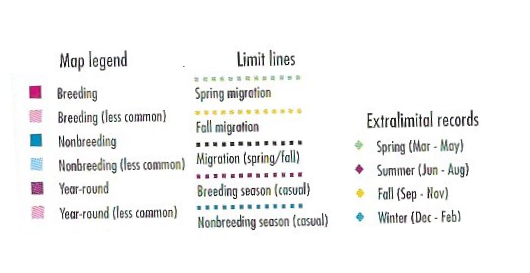
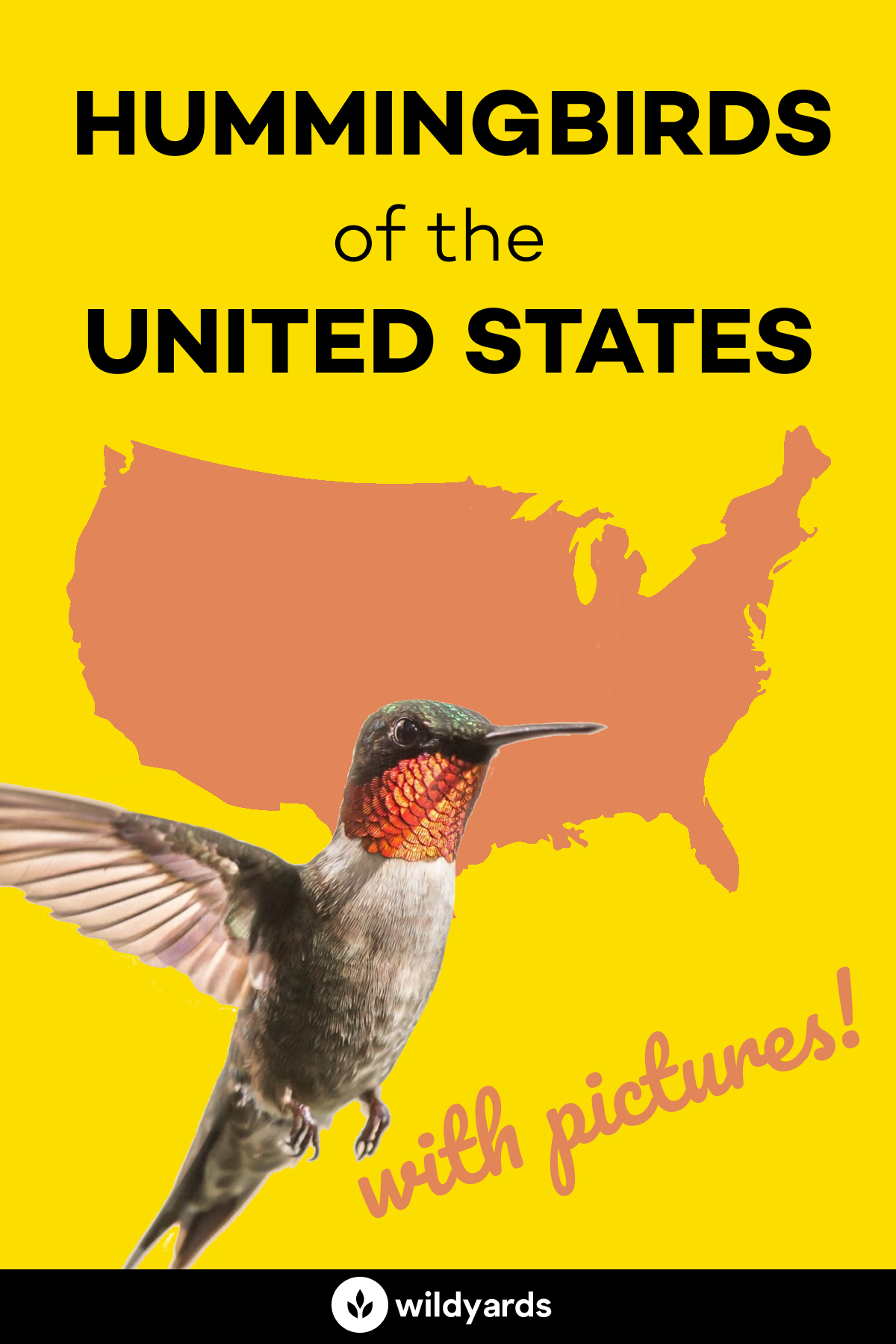
The 21 Hummingbirds in the United States
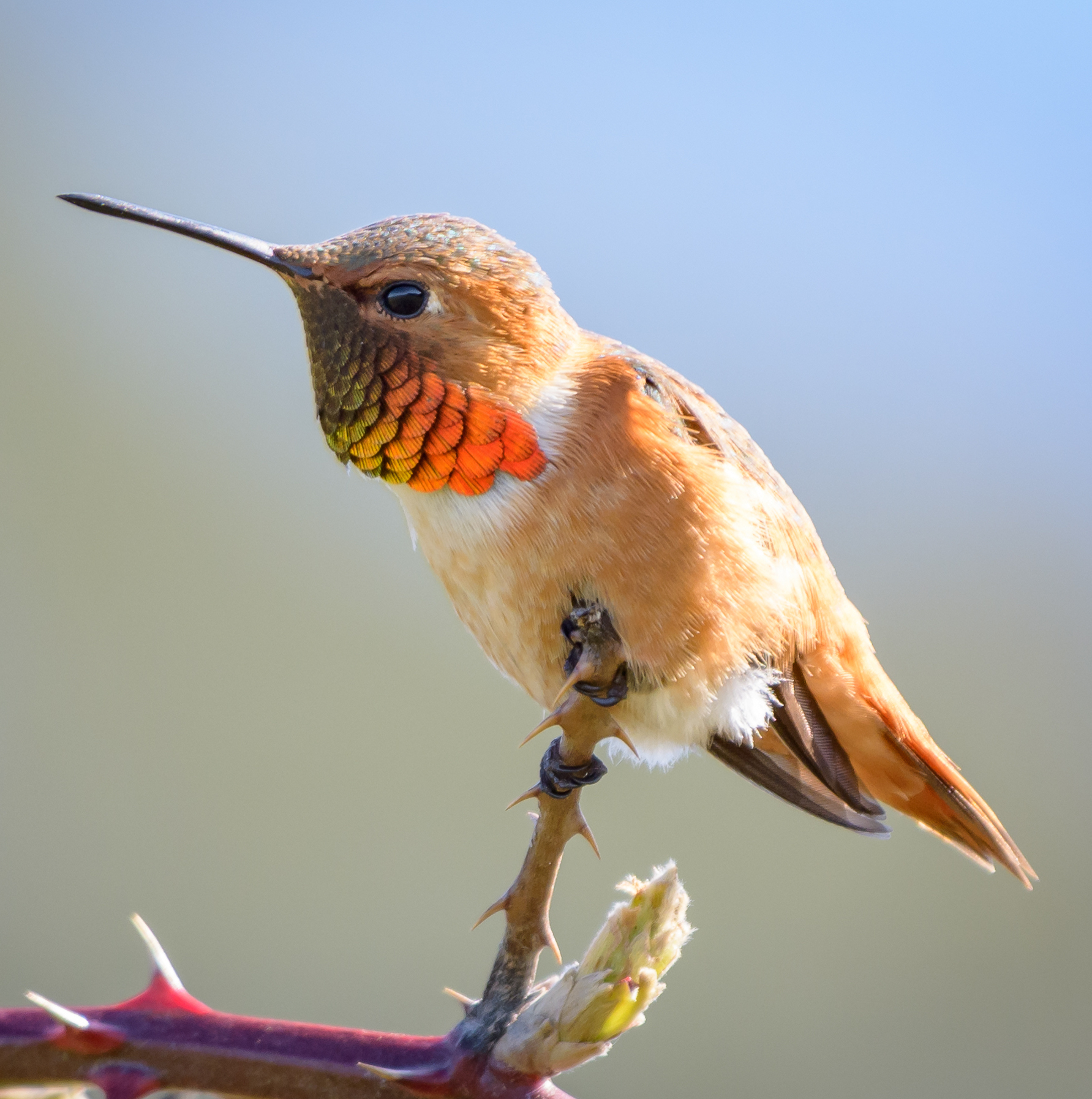
Allen’s Hummingbird
Selasphorus sasin
Order: Apodiformes
Family: Trochilidae
Size: 3.2 – 3.6 in (8-9 cm)
Overview
This small but territorial hummingbird has a medium-short to medium black bill and an extensive rufous plumage. It was named after the Californian bird collector, Charles A. Allen. Allen’s hummingbird has the most restricted breeding ranges of all native North American hummingbirds. Though their habitat has been altered by humans, they’ve adapted well to urban and suburban environments – zipping from feeder to feeder. In their natural environment, they use native plant species such as honeysuckle, bush-monkeyflower, and fuchsia-flowered gooseberry for their nectar needs.
How to Identify
The Allen’s Hummingbird is very difficult to distinguish from the Rufous Hummingbird. In fact, the female and immature males of both species are pretty much indistinguishable. In the adult male, the Allen’s Hummingbird has a green back and rump, but a rufous tail, and the Rufous Hummingbird usually has a rufous back, rump and tail. That’s the easiest way to distinguish the two.
Allen’s Hummingbird Range & Migration Map
The range of Allen’s Hummingbid is one of the smallest and restrictive of all North American Hummingbirds. They’re a common summer resident of northern coastal California and southern Oregon and a year-long resident of southern Californa. During migratory season, can be found in Arizona and even New Mexico.
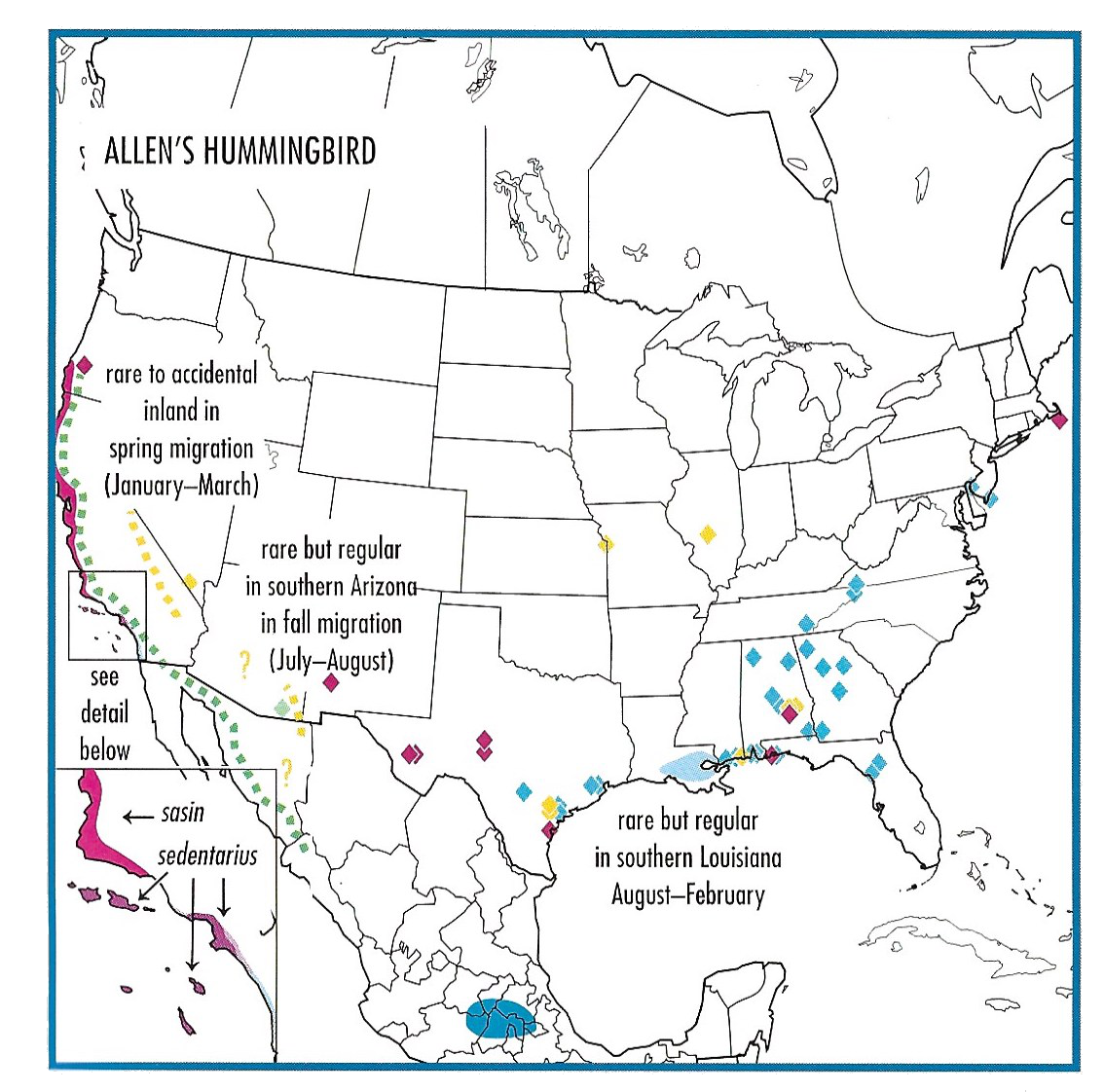
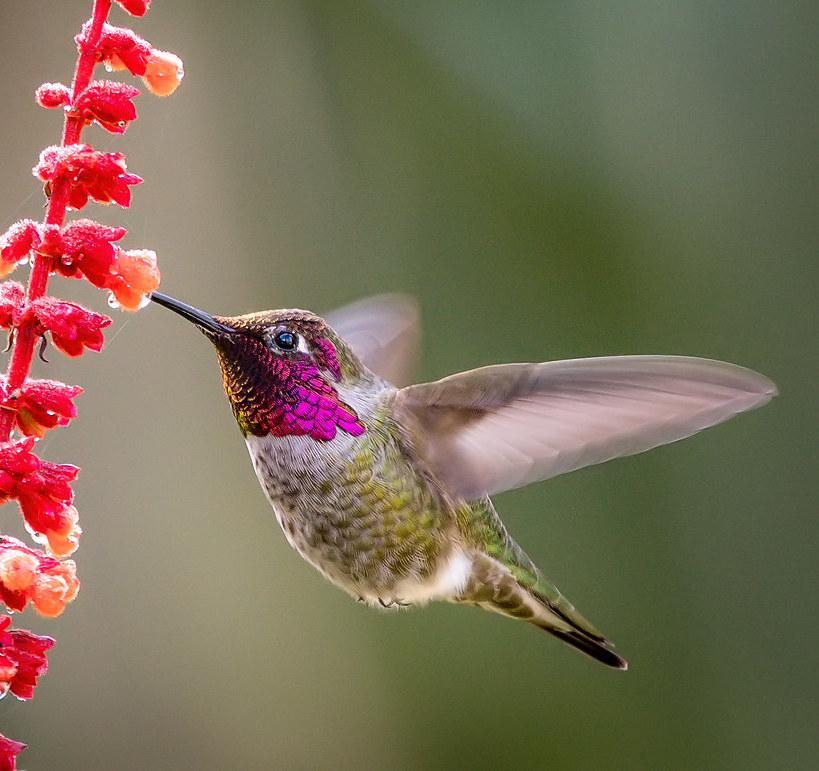
Anna’s Hummingbird
Calypte anna
Order: Apodiformes
Family: Trochilidae
Size: 3.5 – 4in (9-10cm)
Overview
Originally a native to California, the Anna’s Hummingbird is quite adaptable allowing it to expand its range northward and eastward chasing exotic flowers in urban gardens. It’s named in honor of Anna Massena, the Duchess of Rivoli and a generous patron of science. During the winter Anna’s hummingbird has been observed eating insects such as gnats and even eating sand and ashes – likely to provide essential minerals.
How to Identify
Anna’s Hummingbird is a medium-sized hummingbird with a medium sized straight black. bill. The male sports a red gorget. Unlike the Black-Chinned and Costa’s Hummingbird, Anna’s Hummingbird normally holds its tail still while hovering.
Anna’s Hummingbird Range & Migration Map
Anna’s Hummingbird is a common resident in California but has extended its range north towards the western coast of Washington and southeast to southern part of Arizona. It’s a rare winterer of western Texas.
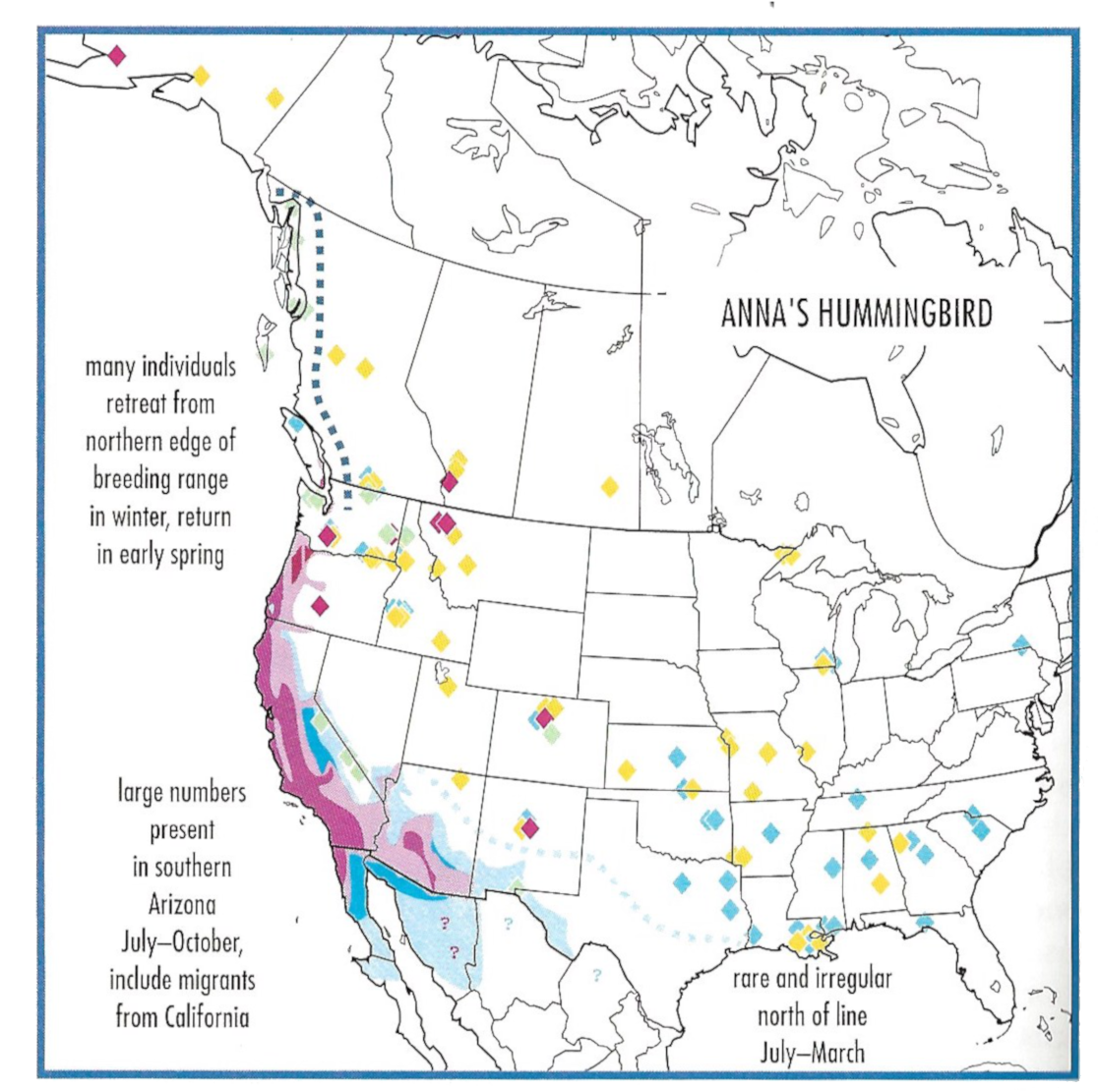

Bahama Woodstar
Nesophlox evelynae
Order: Apodiformes
Family: Trochilidae
Size: 3.1 – 3.7in (8 – 9.5cm)
Overview
This Caribbean bird tends to enjoy fluttering into yards and gardens, however, it’s fairly rare you will see them in the US – as they are a vagrant species. They tend to prefer heading into scrubby areas and woodland in the wild, and as the name suggests, you’ll probably have a good chance of spotting it in the Bahamas.
How to Identify
Male Bahama Woodstars are marked for their lovely purple colorings around the head and throat, while females are easy to spot thanks to orange twinges along their bodies. Woodstar calls are also distinctive, with experts remarking their production of almost ‘metallic’ noises – through call and through tail flitting. It’s also one of few hummingbirds with a tail fork.
Bahama Woodstar Range & Migration Map
The Bahama woodstar is a Bahamas native, though sightings have been made in the southeastern reaches of Florida. It’s generally seen as a non-migratory bird, instead choosing to propagate in woody and tropical gardens of its homeland.
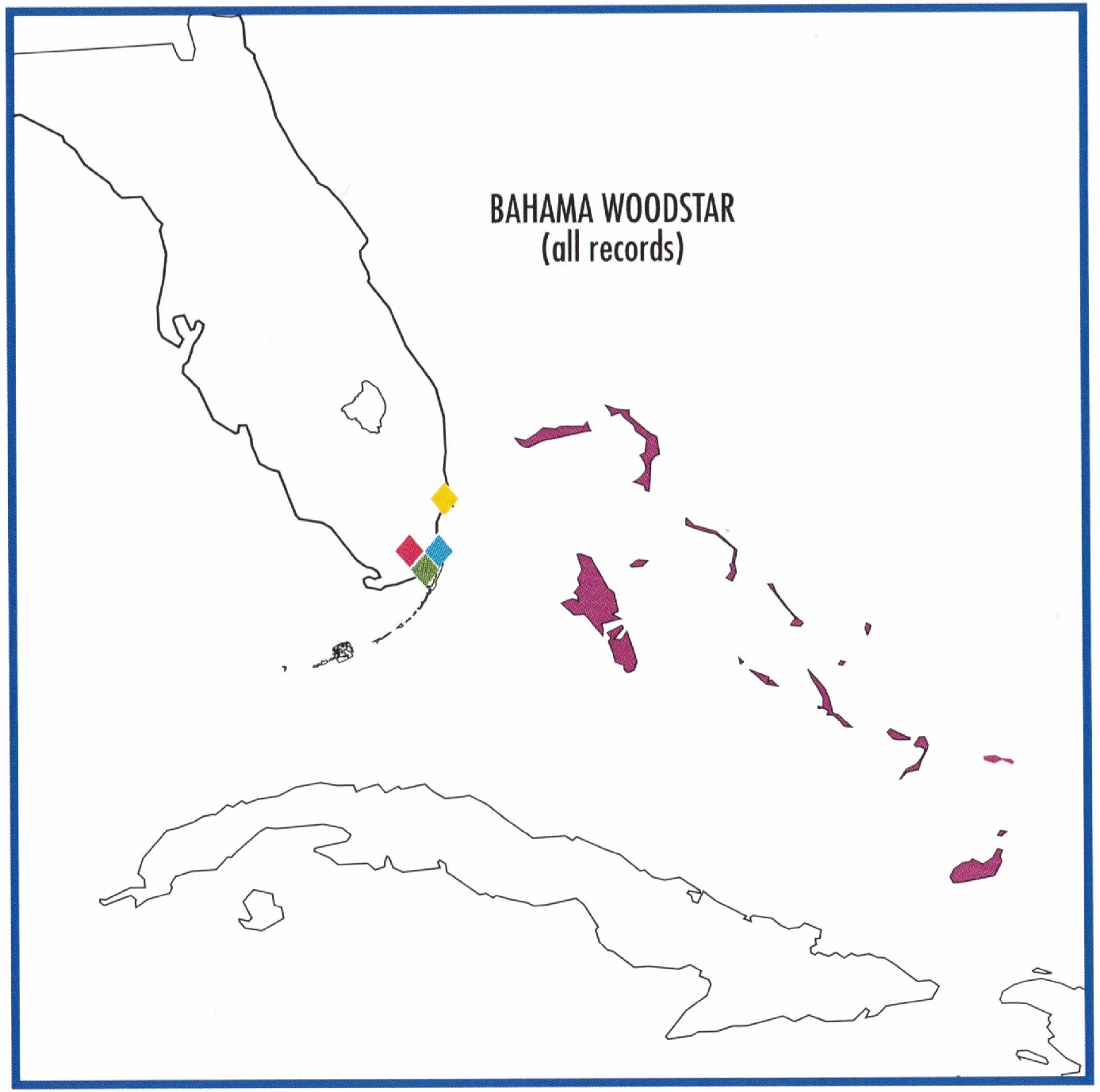
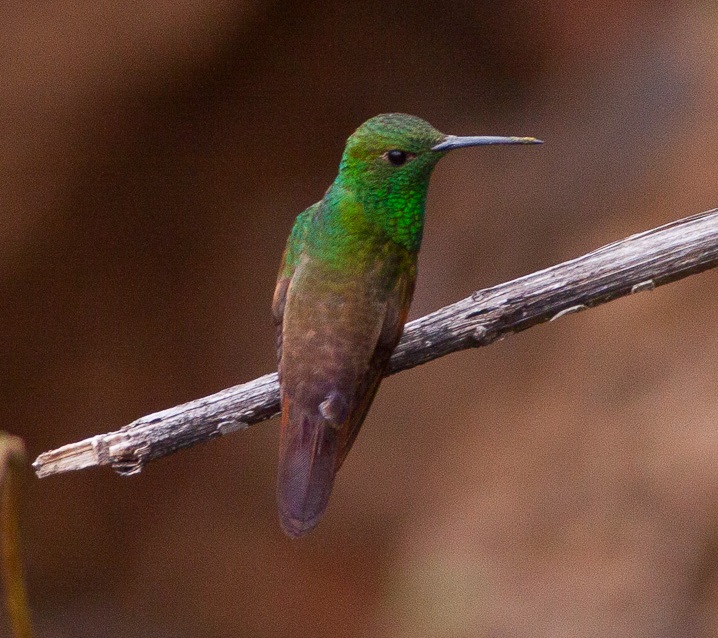
Berylline Hummingbird
Saucerottia beryllina
Order: Apodiformes
Family: Trochilidae
Size: 3.1 – 3.9in (8 – 10cm)
Overview
The berylline hummingbird is a frequent US visitor from Mexico and is best known for its colorful plumage and its trumpeting call. These hummingbirds feed in a variety of ways, whether through hovering and plucking from feeders or snapping insects out of the air. They’ve been a part of the wild landscape in the US since the 1960s, and you’ll normally see them in the summertime.
How to Identify
Gorgeously green crested and crowned, The berylline hummingbird will normally visit you if you live around Arizona, close to forests and towards the sunnier months. These are US visitors, meaning you can’t guarantee to see them all year round. As mentioned, they have distinctive calls and tend to prefer hillier areas.
Berylline Hummingbird Range & Migration Map
The Berylline Hummingbird is classed as a ‘vagrant’ species in that it usually travels from Mexico to Arizona, western Texas, and southwestern New Mexico during the summer months, traveling into the mountain forests. It doesn’t tend to migrate, rather, it prefers to switch elevation to stay warm during the winter.
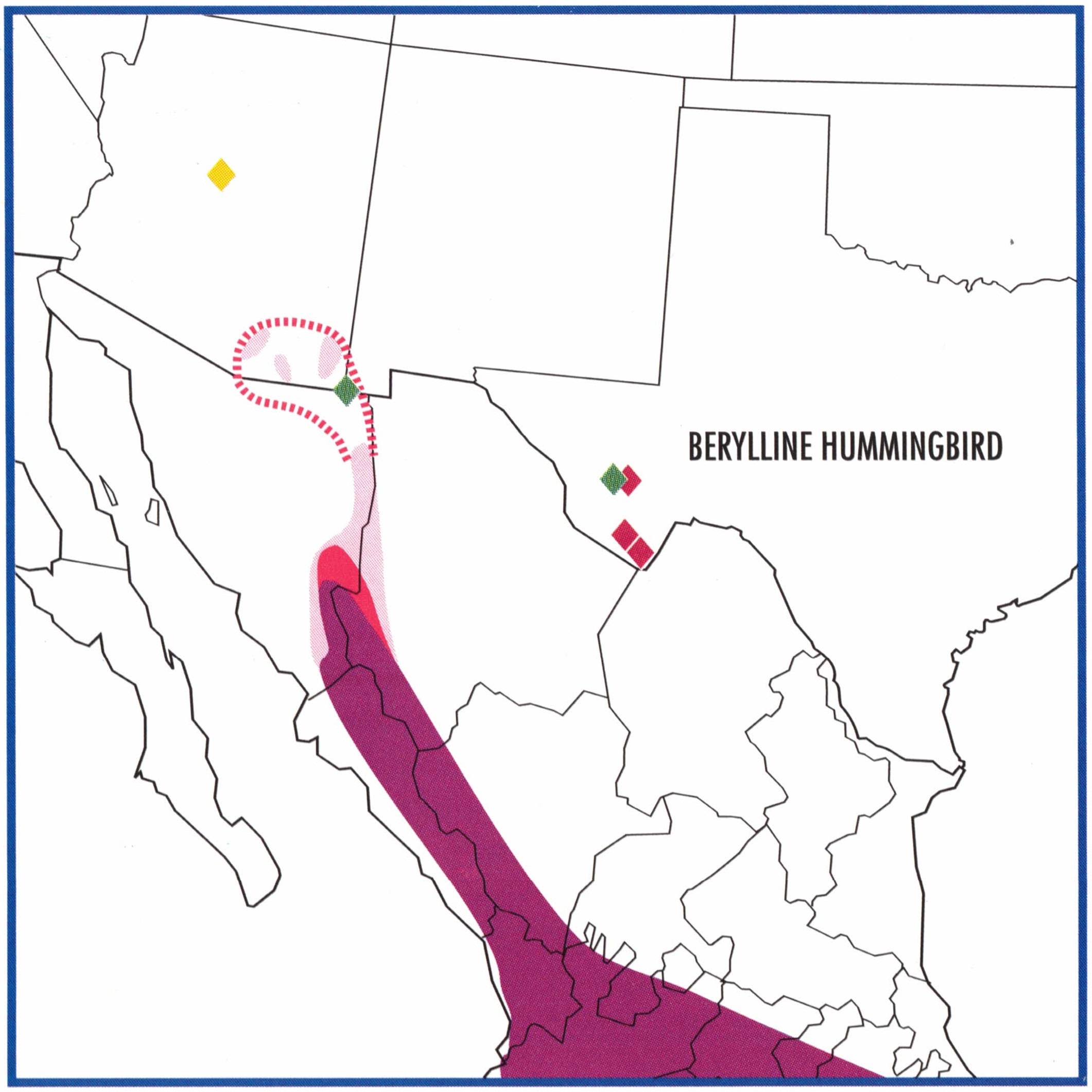
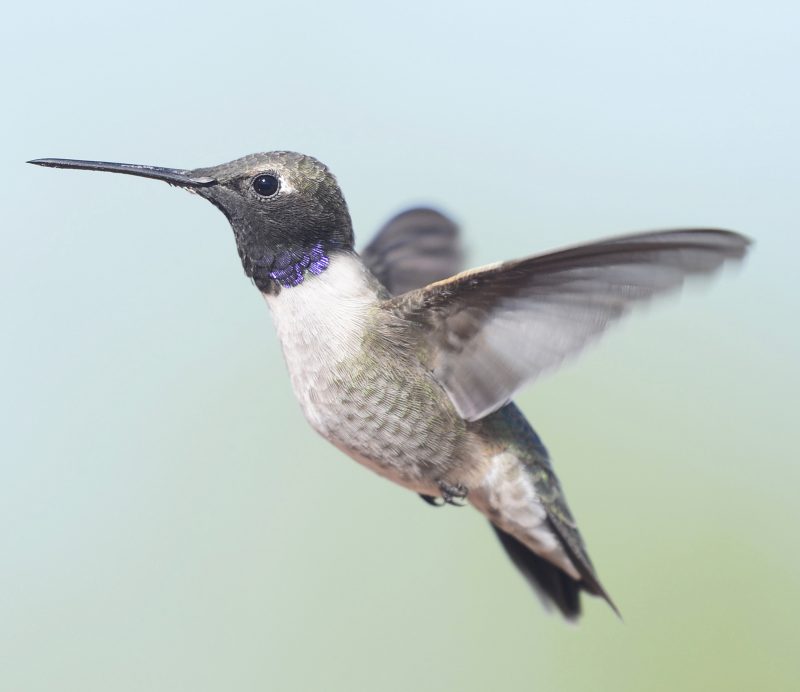
Black-Chinned Hummingbird
Archilochus alexandri
Order: Apodiformes
Family: Trochilidae
Size: 3.25 – 3.75 in (8.5 – 9.5cm)
Overview
The Black-Chinned Hummingbird is the western counterpart of the Ruby-Throated Hummingbird. The species was named in 1846 to honor its discoverer – Dr Alexandre. It can be found in most types of habitats, including backyards, all over the western United States. It pumps its tail almost constantly while in flight and isn’t picky about what plants it takes nectar from.
How to Identify
The Black-Chinned Hummingbird is a small hummingbird with a medium to long decurved bill and a grey crown. It’s gorget is mostly black with a hint of violet in the correct sunlight.
Black-Chinned Hummingbird Range & Migration Map
The small hummingbird breeds in most the western states, going as far east as eastern Texas. Can be found during the winter in the southern states bordering the Gulf of Mexico.
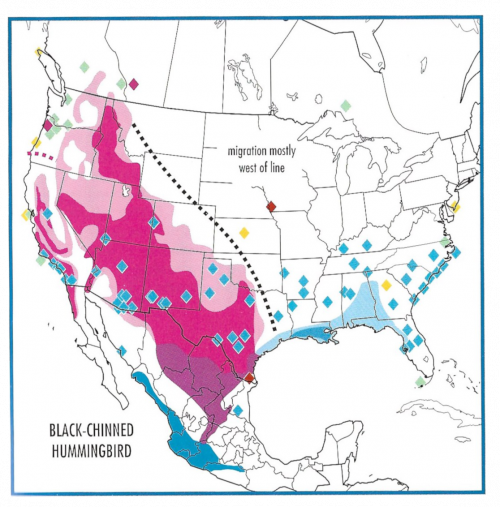
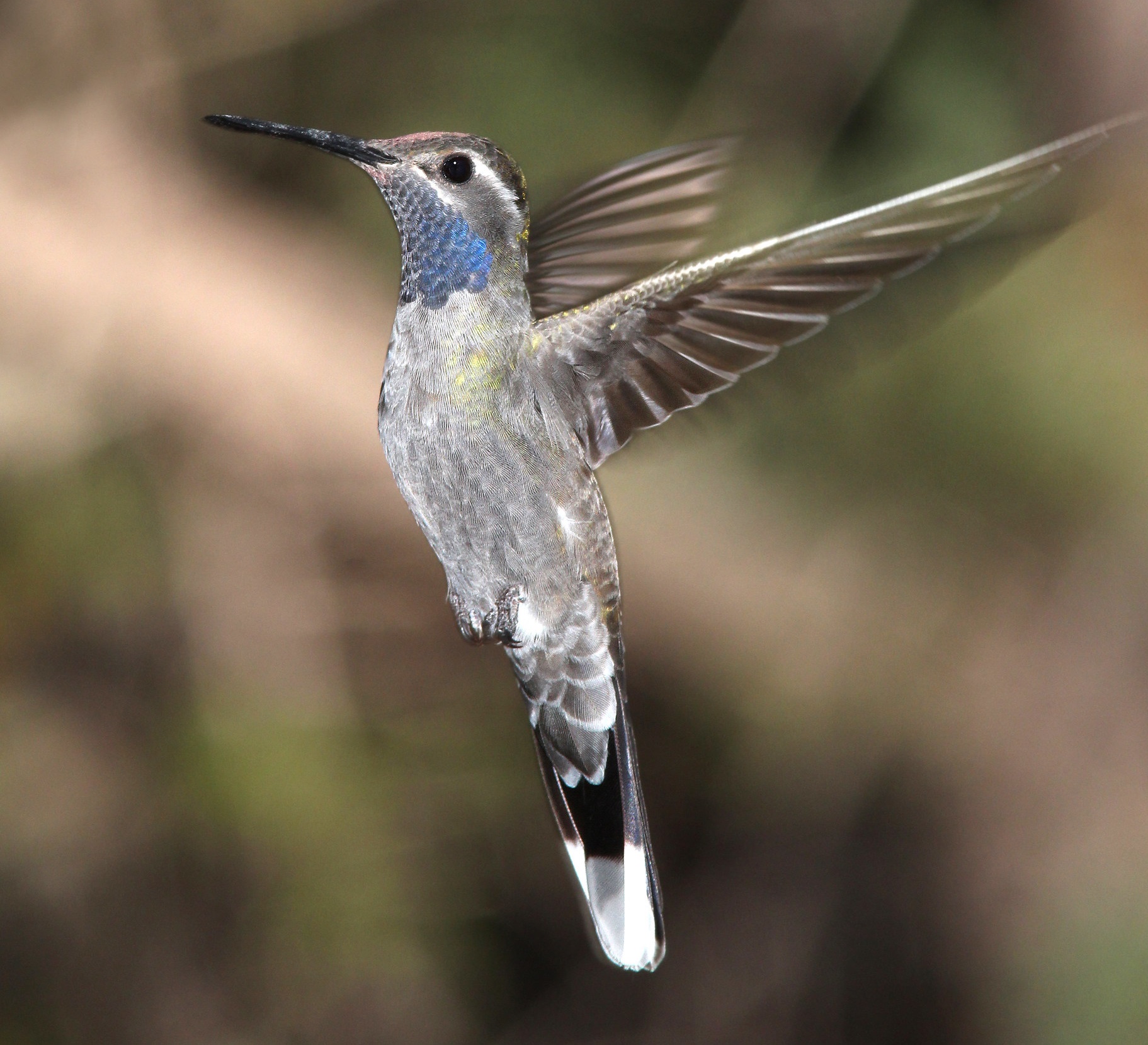
Blue-Throated Mountain-gem
Lampornis clemenciae
Order: Apodiformes
Family: Trochilidae
Size: 4.3 – 4.7in (11 – 12cm)
Overview
The blue-throated mountain-gem is an extremely rare species of US hummingbird that you will find hiding out in forests of oak and pine. It’s also one of the biggest you will find across the states, even though there are said to be fewer than 2,000 living in the country right now. They tend to enjoy feeding on sugar water and you’ll find them fluttering around in open woods. They can live to an impressive age, with the oldest on record having been almost eight years old.
How to Identify
Blue-throated mountain-gems are, as mentioned, fairly large – they are stunning to watch from afar, and what’s more, you will be able to spot them thanks to their white striping around their beaks. As their names suggest, they have blue throats, and they tend to be some of the more vocal hummingbirds, often singing together.
Blue-Throated Mountain-gem Range & Migration Map
If you are lucky, you may be able to spot these hummingbirds across the forests of southern states, specifically in the mountain ranges of western Texas, southern New Mexico, and southeastern Arizona. They tend to group up near mountains, too, though it’s not unheard of to see them in backyards across these states. They have been spotted in Colorado (July to August), Louisiana (fall, spring), California (summer), South Carolina (August), North Dakota (June), and Utah (August) during their migratory seasons.
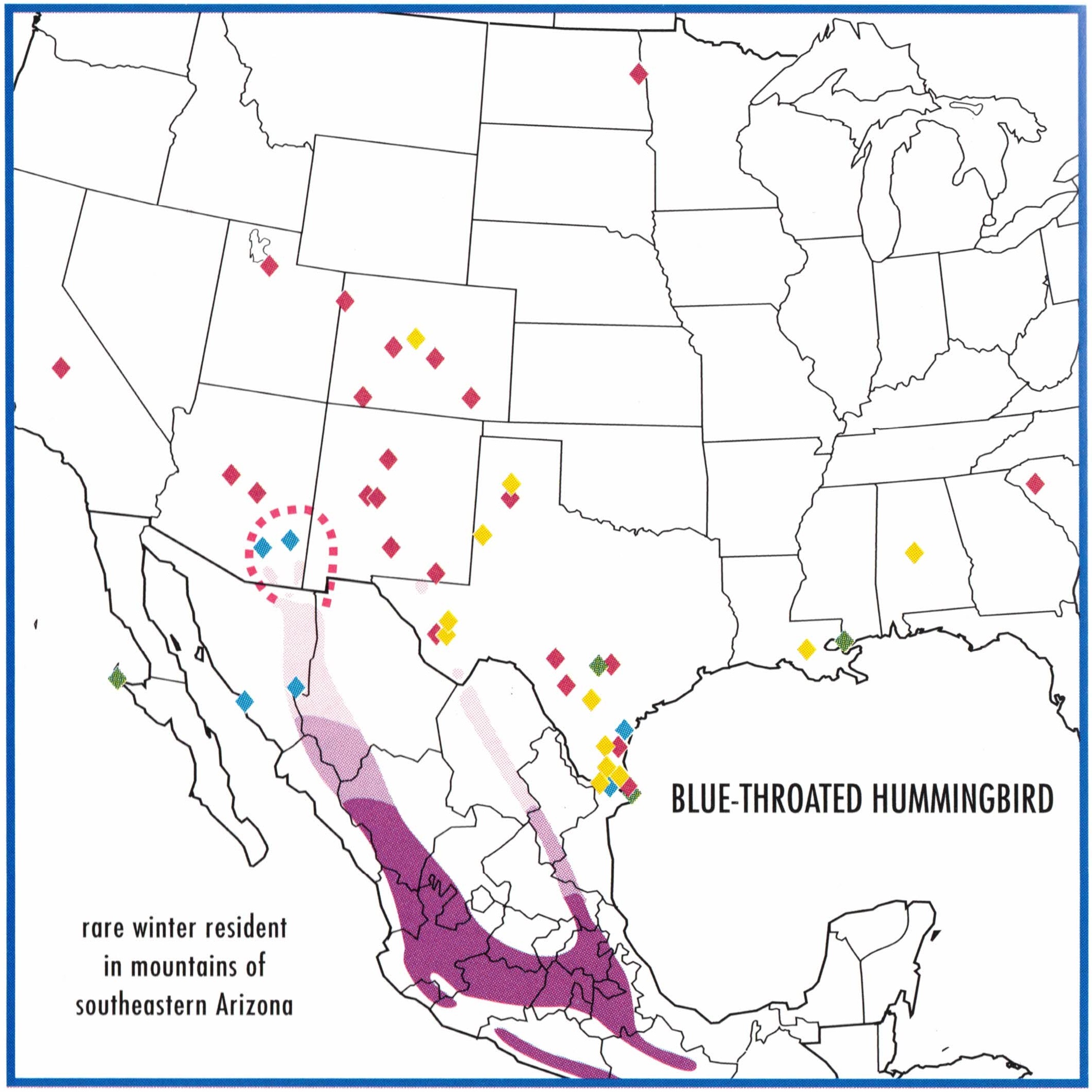
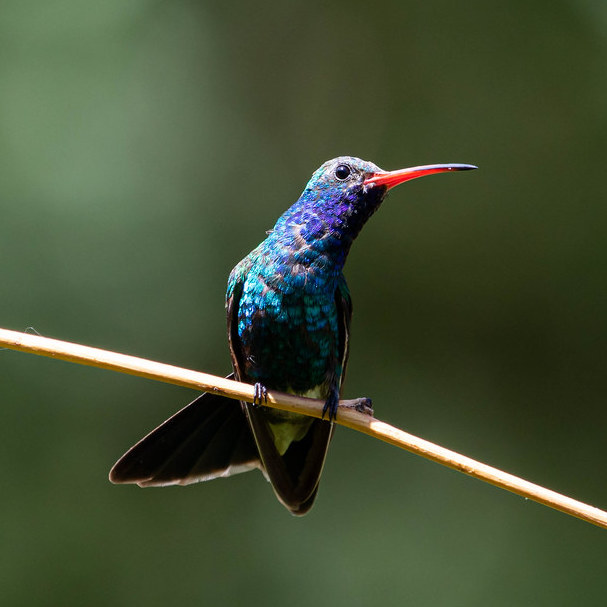
Broad-Billed Hummingbird
Cynanthus latirostris
Order: Apodiformes
Family: Trochilidae
Size: 3.5 – 4in (9-10cm)
Overview
This southwestern hummingbird is one of the most mild-tempered. It’s rare to see two males fighting over territory or females. Their quite uninspired name comes from the literal translation of its species name – cynanthus latirostris. It’s sound is unique from all other North American hummingbirds as it consists mostly of raspy and almost insect-like chattering.
How to Identify
The male Broad-Billed hummingbird is easy to distinguish. Some of it’s more defining features include a long broad bill, long and constantly-moving tail, and a glittering sapphire blue neck.The female and male are close in size and proportions.
Broad-Billed Hummingbird Range & Migration Map
The Broad-Bill Hummingbird is a rare resident in shrub thickets and canyons. Most often found in southern Arizona and southwest New Mexico at elevations above 5,000ft. In migratory season, this hummingbird has also been sighted in Texas and California.
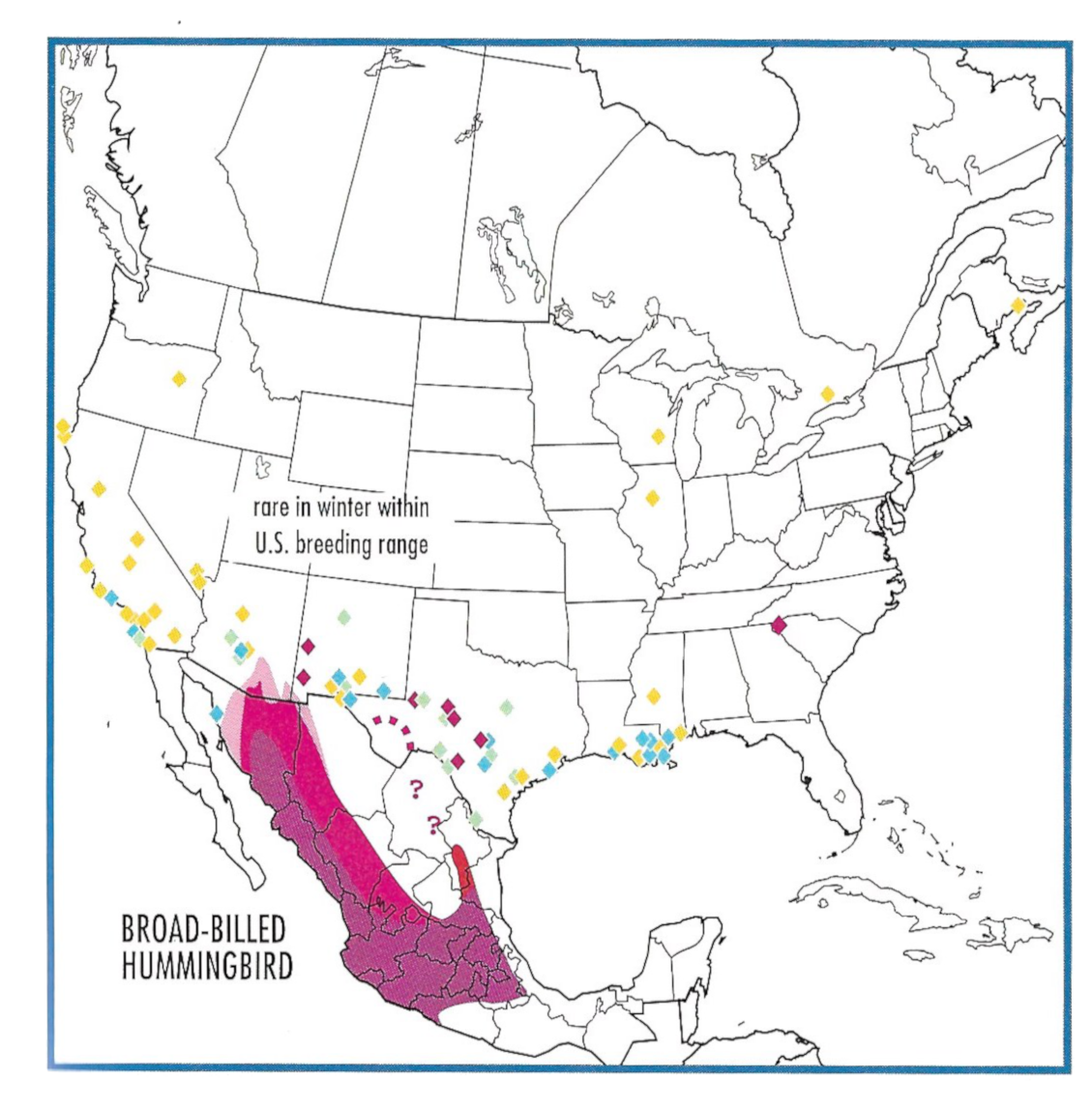
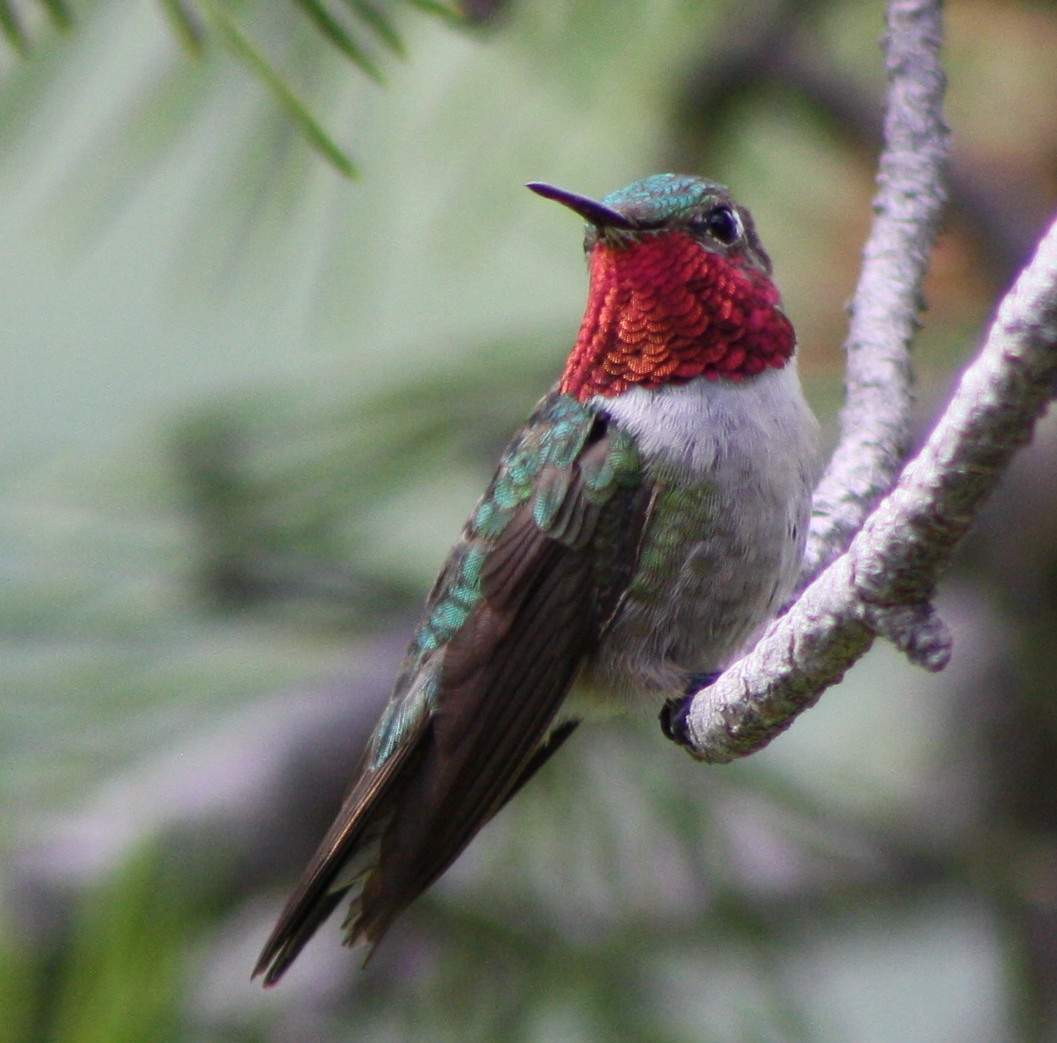
Broad-Tailed Hummingbird
Selasphorus platycercus
Order: Apodiformes
Family: Trochilidae
Size: 3.75 – 4in (9.5 – 11cm)
Overview
This medium-sized hummingbird is one of the most hummingbirds of the Rocky Mountains. Their call, which resembles the ringing of tiny bells, is a common sound during the Rocky Mountain summers. Fun fact, a female Broad-Tailed Hummingbird is the oldest known wild hummingbird in the United States reaching a ripe old age of 12 years.
How to Identify
The Broad-Tailed male hummingbird sports a hot pink gorget which contrasts with a white breast. It’s medium-sized with a a decently long tail and straight black bill. It’s a mild-manned hummingbird that is easily bullied by other hummingbirds.
Broad-Tailed Hummingbird Range & Migration Map
The Broad-Tailed Hummingbird breeds from Wyoming and central Idaho down to Mexico. Winters in Mexico and can rarely be found along the Gulf of Mexico states. It prefers mountain forests and woodlands.
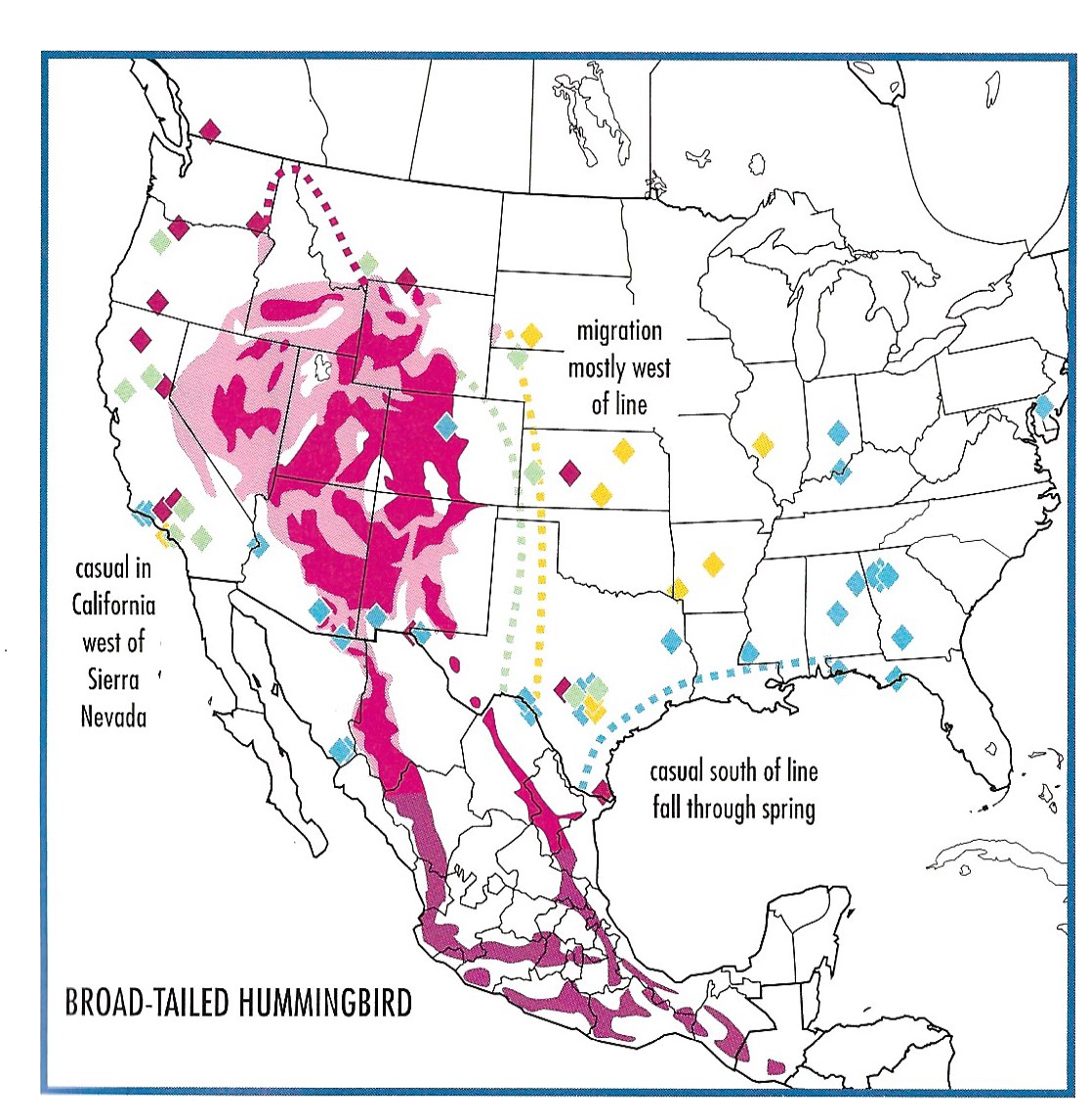
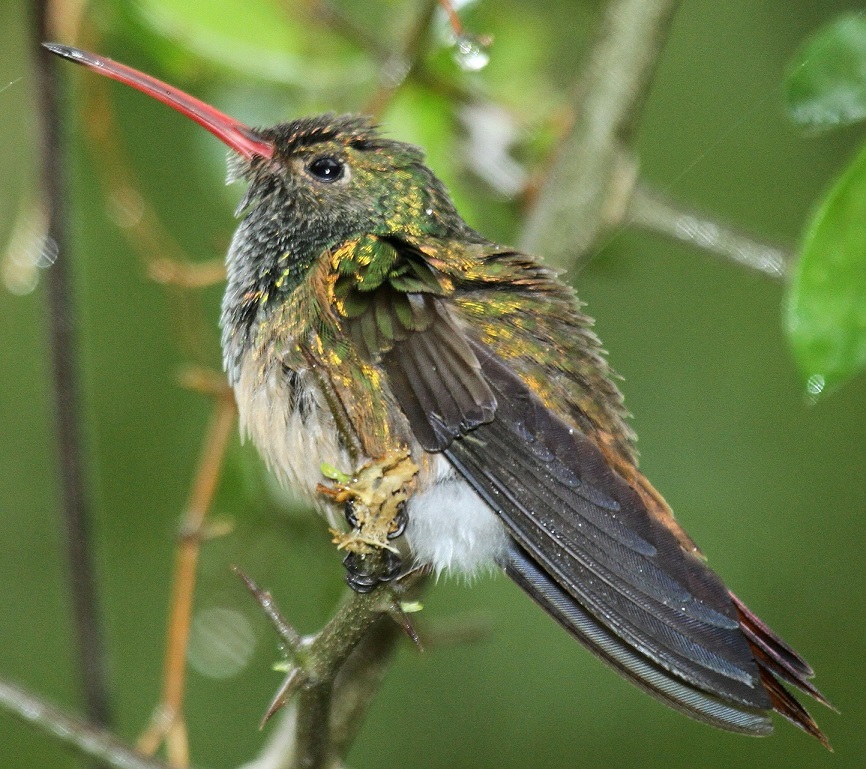
Buff-Bellied Hummingbird
Amazilia yucatanensis
Order: Apodiformes
Family: Trochilidae
Size: 3.9 – 4.3in (10 – 11cm)
Overview
The buff-bellied hummingbird tends to be a common sight down in Texas and along to Mexico, and there are thought to be around 100,000 in the US wild. Intriguingly, this is the only hummingbird species that chooses to drift northeast occasionally. They’re normally easy to spot in Texan forests that are particularly dry or arid.
How to Identify
This beautiful hummingbird is generally easy to spot thanks to its orange-tinted feathers and its bright red beak! As its name suggests, it has a buff or yellowish stomach, and you will normally be able to spot Buff-bellied eggs in nests from early spring to late summer. They generally choose to breed in southern Texas, so you may spot a handful in these yards and gardens.
Buff-Bellied Hummingbird Range & Migration Map
While the Buff-bellied hummingbird breeds in the Texan south, they live across the state and the central gulf. They tend to migrate up along the gulf coast at the end of the breeding season and have been spotted as far afield as western Florida when winter rolls around.
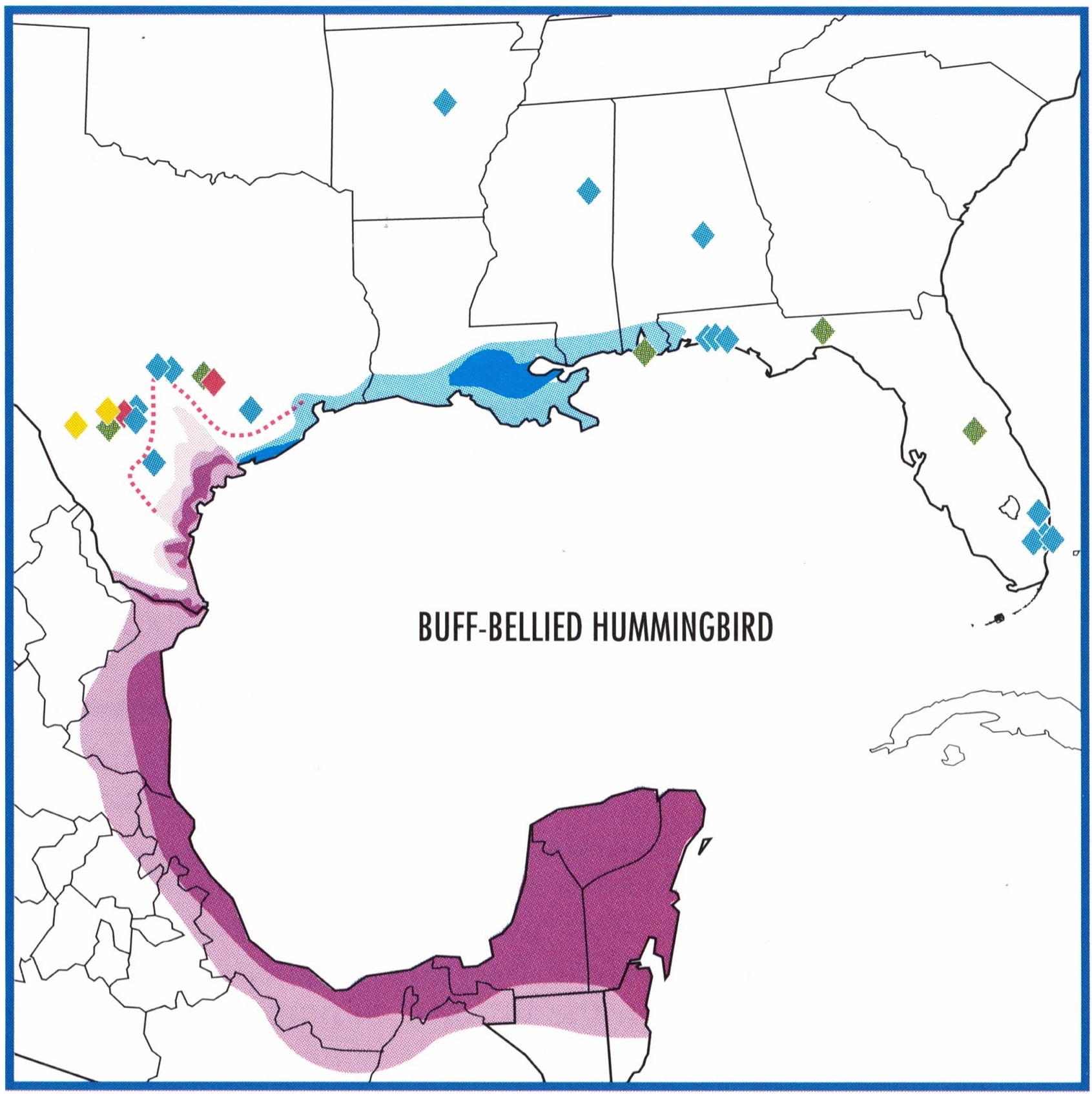
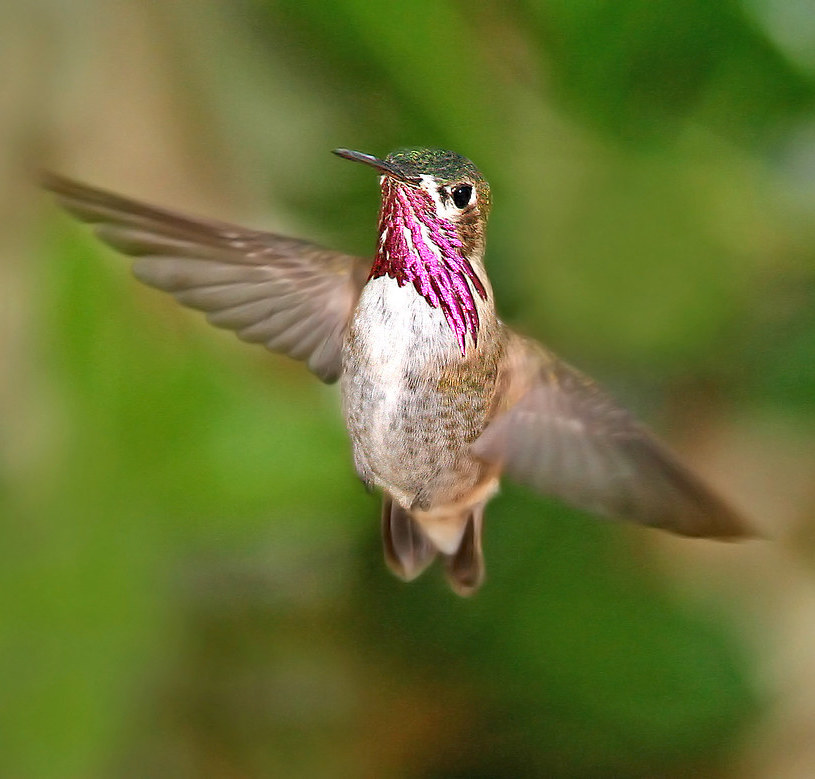
Calliope Hummingbird
Stellula calliope
Order: Apodiformes
Family: Trochilidae
Size: 2.75 – 3.25in (7.5 – 8cm)
Overview
The Calliope Hummingbird is the smallest breeding bird in the United States. In fact, the male weighs less than a penny. The Calliope’s species name is Greek for “beautiful voice” which is rather ironic given that this hummingbird has limited vocal ability. This hummingbird prefers habitats in conifer forests and older growth following forest fires.
How to Identify
The Calliope Hummingbird is a really small bird with a short black bill and short tail. The male sports a red to purple gorget with a white background. It’s very small size should distinguish it from other hummingbirds rather easily.
Calliope Hummingbird Range & Migration Map
The Calliope Hummingbird breeds in the northwestern states starting from northern California. During the winters, it can be found in the states along the Gulf of Mexico. During migration season, they can be found following both the Rocky Mountain and Pacific ranges.
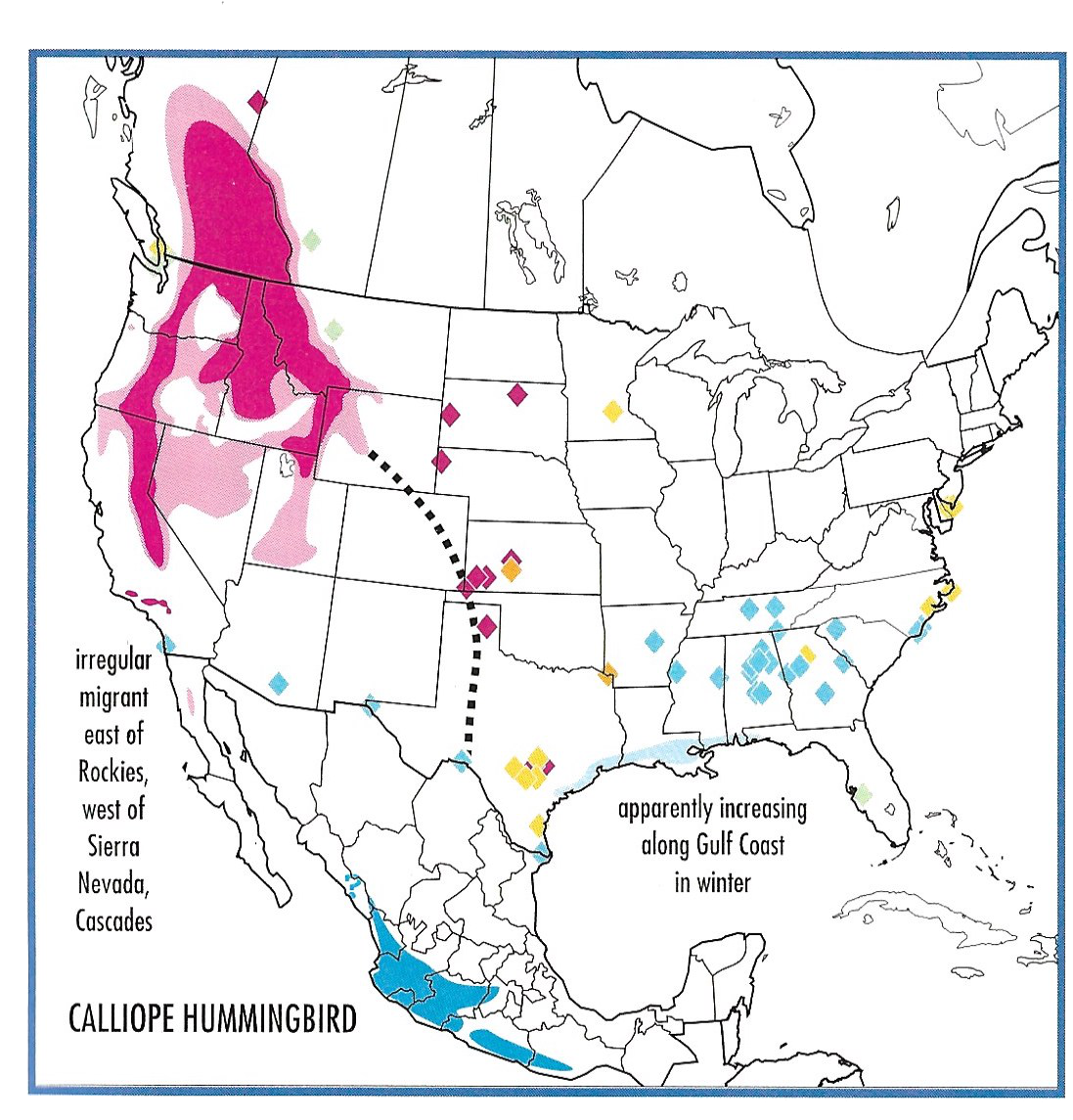
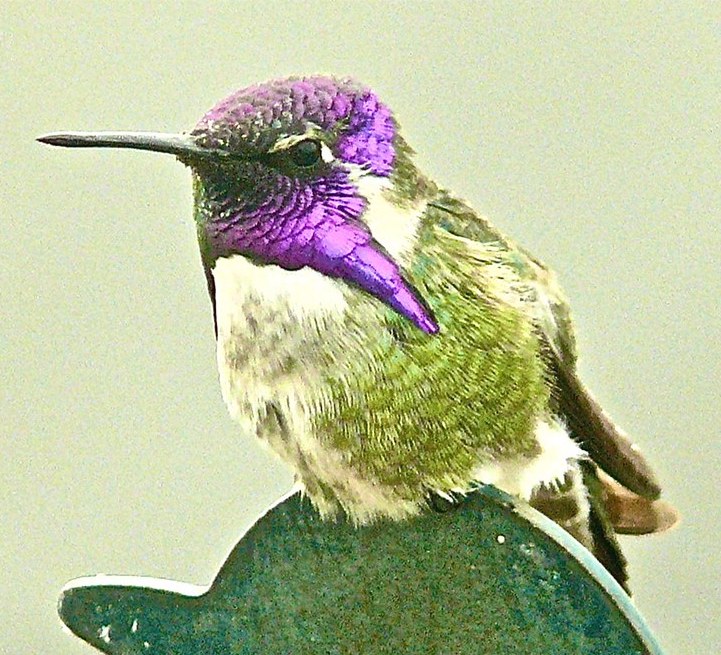
Costa’s Hummingbird
Calypte costae
Order: Apodiformes
Family: Trochilidae
Size: 3 – 3.5in (7.5 – 9cm)
Overview
The Costa’s Hummingbird is a desert hummingbird that has been edged out of its natural habitat by urbanization. Most commonly found in the Sonoran and Mojave Deserts. It’s named in honor of Louis Costa, who was an early collector of hummingbird specimens.
How to Identify
The “Fu Manchu” gorget of adult males is pretty much impossible to miss and makes the males easy to identify. But the females are easy to confuse with Anna’s or Black-Chinned hummingbirds. Anna’s female hummingbirds have longer and larger bills and longer tails that, unlike Costa’s are rarely seen being “pumped” while in flight.
Costa’s Hummingbird Range & Migration Map
The Costa’s hummingbird breeds in scrub habitats and thrives in the Sonoran and Mojave deserts. It’s a resident in southern California and southwestern Arizona but during the breeding season can be found in northern California and east to central Arizona.
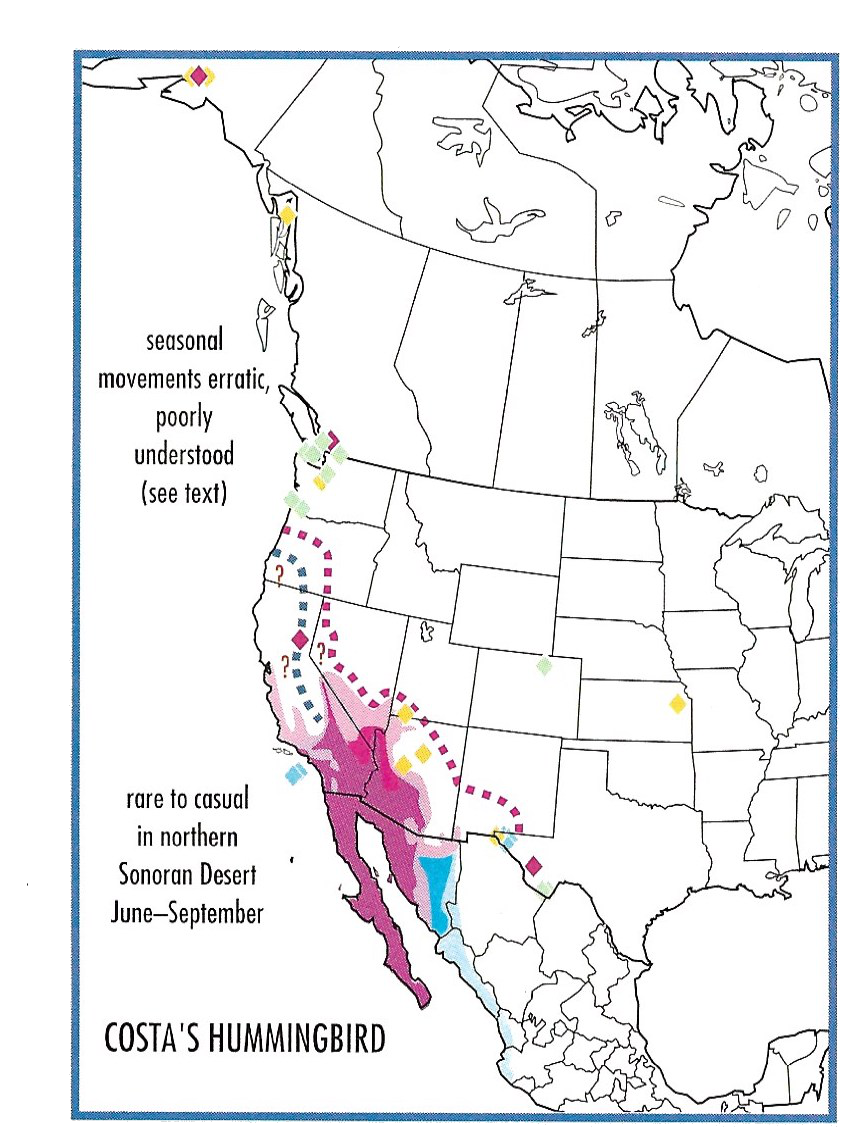
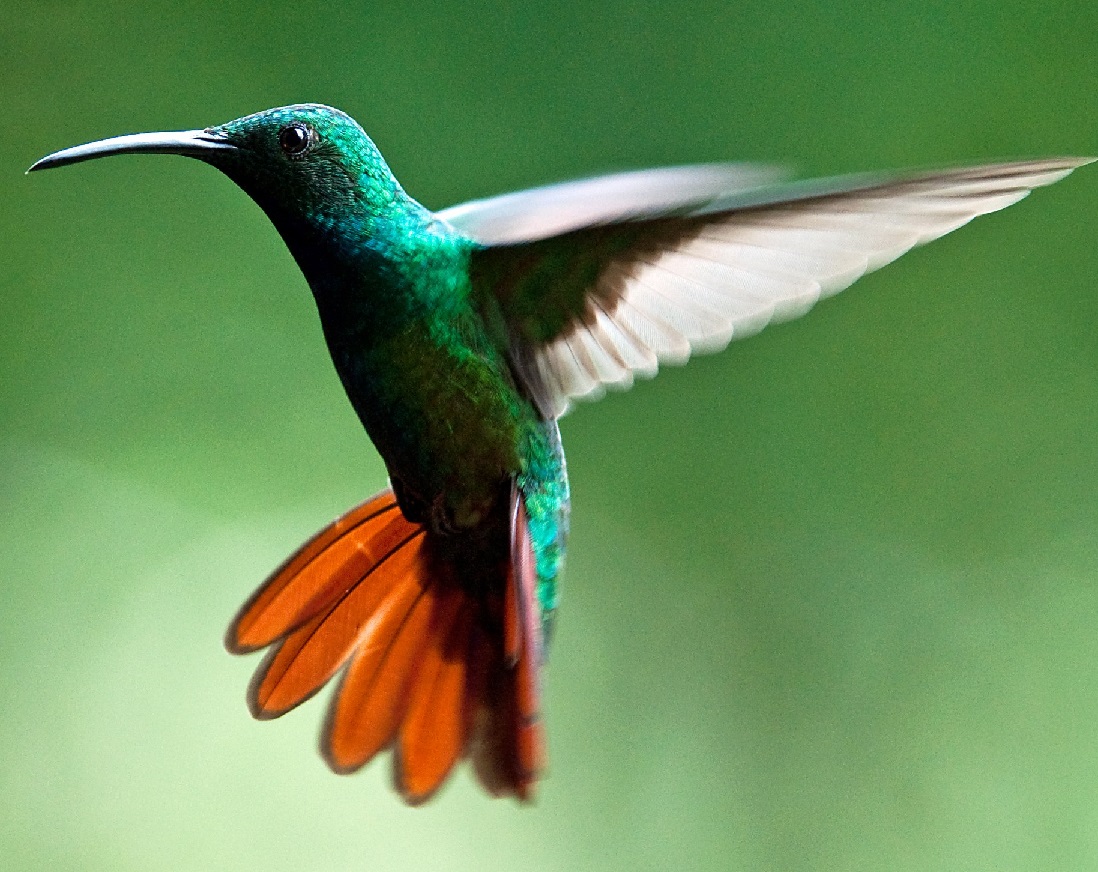
Green-Breasted Mango Hummingbird
Anthracothorax prevostii
Order: Apodiformes
Family: Trochilidae
Size: 4.2 – 4.7in (11 – 12cm)
Overview
This species of hummingbird is a vagrant traveling into the US from Mexico, and is usually a friendly visitor of wide-open spaces. They prefer traveling into backyards for easy feeding compared to deeper forests and wooded areas. These hummingbirds are particularly keen on snapping insects out of the air as they fly past.
How to Identify
A larger species than many, the Green-breasted mango is dark green to the plumage and has a bluish tint to the stomach. It’s also noted for having a large, curved bill. You’ll normally be able to tell a male by its red tail, while female tails are much darker. Females also have spots of white scattered across their bodies.
Green-Breasted Mango Hummingbird Range & Migration Map
Though rarer than native species, this hummingbird is a common vagrant to spot across Texas, though it’s been seen as far across as North Carolina, and has even been spotted out in Wisconsin and Georgia. Being a tropical bird, you are more likely to find it nesting down towards Central and South America.
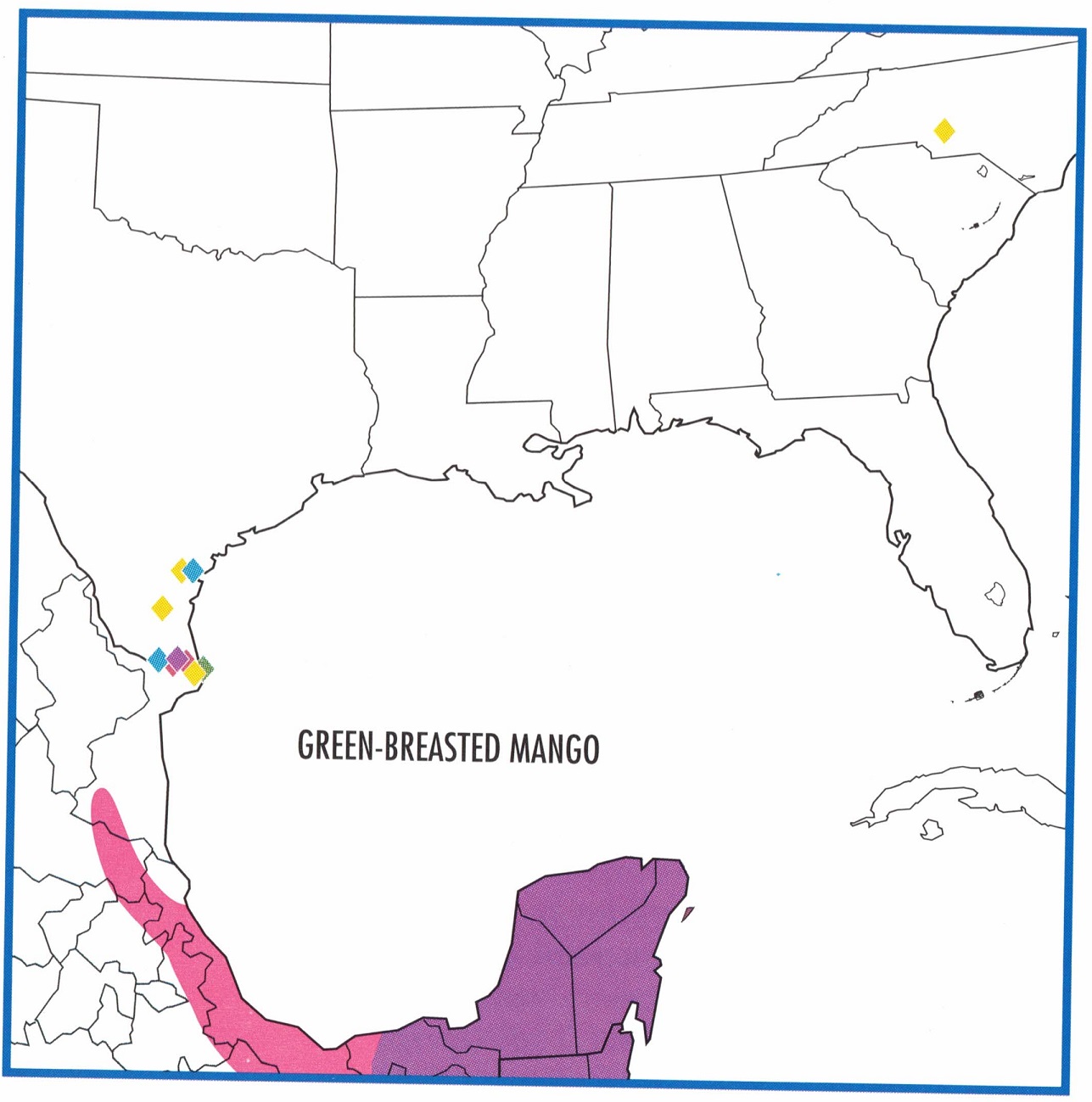
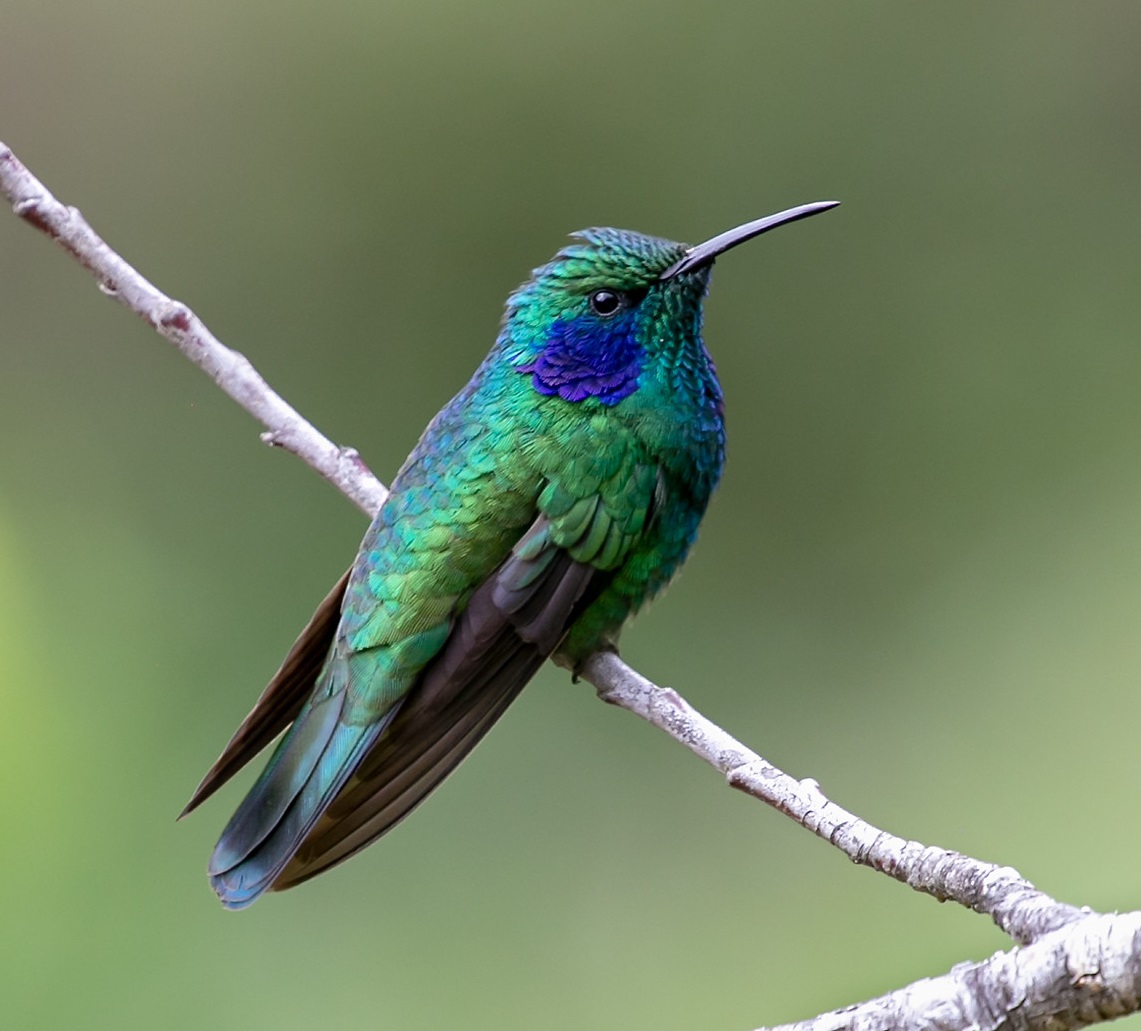
Green-Violet Ear Hummingbird
Colibri thalassinus
Order: Apodiformes
Family: Trochilidae
Size: (9.7 – 12cm)
Overview
Otherwise known as the Mexican violet ear, this hummingbird is a vagrant species that frequent southern states via Mexico. It’s regarded as something of a nomad, and they tend to prefer forest clearings to breed in. They are some of the most striking hummingbird species traveling in this direction – though they are known to be quite aggressive, and will chase other species off a feeder.
How to Identify
This hummingbird has a stunning array of green plumes and purple patches to the ears, with a dark pair of wings and a blue-tinted tail. Telling the difference between males and females can be difficult, however, males are thought to be a little more striking or bold in color.
Green-Violet Ear Hummingbird Range & Migration Map
The green violet ear is a born wanderer, with more than 30 different records indicating visitations to eastern Texas in the past 60 years. However, it’s also been spotted traveling from Mexico and Central America as far and as wide as Alabama, Arkansas, California, Colorado, Kentucky, Louisiana, Michigan, Mississippi, Montana, North Carolina, Ohio, Oklahoma, and Wisconsin.

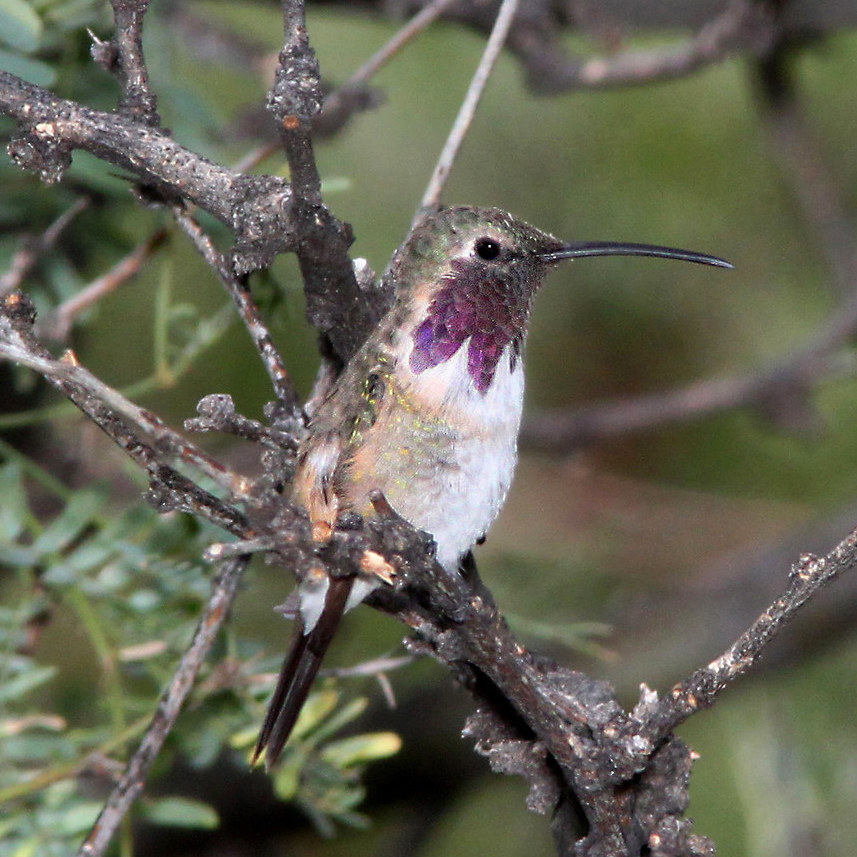
Lucifer Hummingbird
Calothorax lucifer
Order: Apodiformes
Family: Trochilidae
Size: 3.5 – 4in (9-10cm)
Overview
The Lucifer Hummingbird is a rare visitor to the United States, but has been seen in Arizona and New Mexico. Its name most likely comes from its decurved bill or forked tail which distinguishes it from any other American hummingbird species. It often sits in a hunched position – head forward and shoulders rounded.
How to Identify
The distinguishing features of the Lucifer Hummingbird includes its long black and decurved bill, and it’s long, narrow and forked tail. Often confused with the Calliope Hummingbird, but can be distinguished by the tail size. The Calliope hummingbird has a much shorter and broader tail.
Lucifer Hummingbird Range & Migration Map
The Lucifer Hummingbird breeds in western Texas, southwestern New Mexico, and southeastern Arizona. It prefers a habitat of shrubby foothills or streams with sycamores at elevations between 3,800 and 5,700 feet.
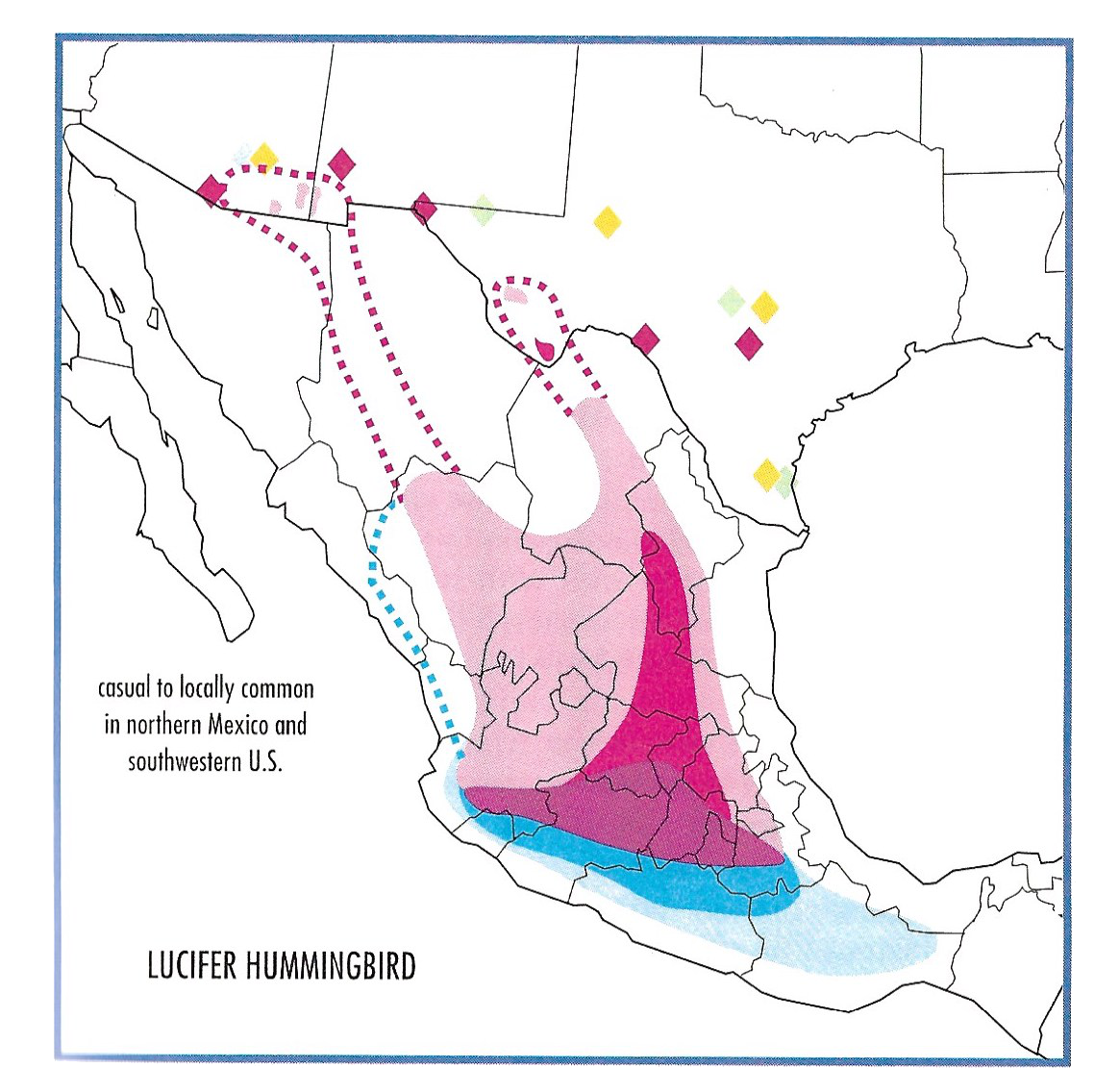
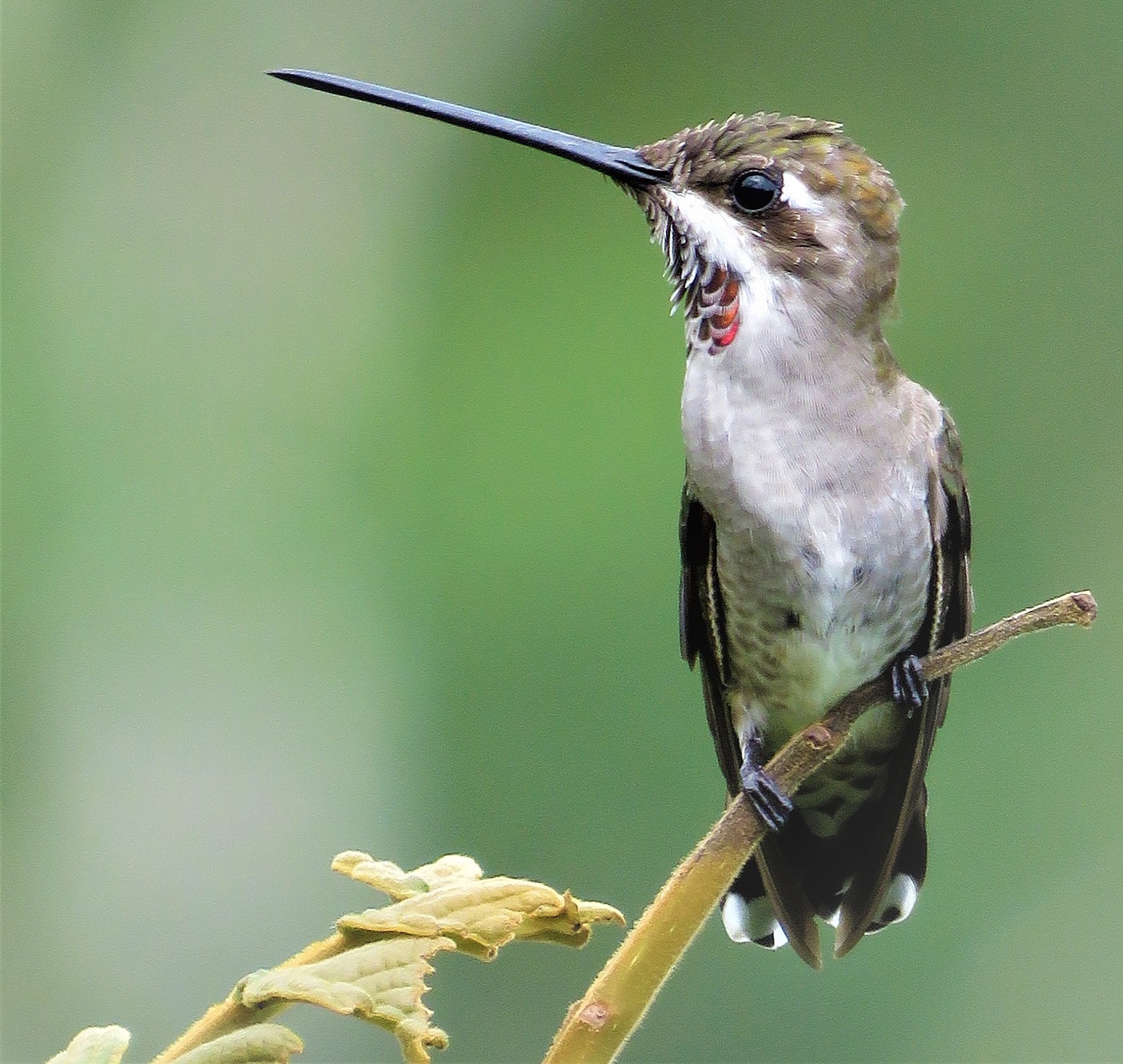
Plain-Capped Starthroat
Heliomaster constantii
Order: Apodiformes
Family: Trochilidae
Size: 4.33 – 4.72in (11 – 12cm)
Overview
This larger hummingbird species with a fantastic name (in English and Latin) enjoys eating at feeders, though you likely won’t spot them elevating too highly. They tend to prefer their own company, though you will see them breeding in their native home, Mexico. This slightly defensive bird prefers being close to water and will even venture out towards canyon land.
How to Identify
Oddly, despite the name ‘starthroat’, this hummingbird is one of the least distinctive of species, with generally duller colors than most. It has a light patch of color to its throat, though it’s not easy to spot from afar. Its main colors are brown and gray with white whiskers, and it tends to be a little larger than native species close by.
Plain-Capped Starthroat Range & Migration Map
This is a vagrant species that is uncommon even as a visitor into the south of the US, only generally seen in the southeast of Arizona, New Mexico, & Texas, traveling from out of Mexico – as of now, they’re not known to breed inside the North American continent whatsoever.
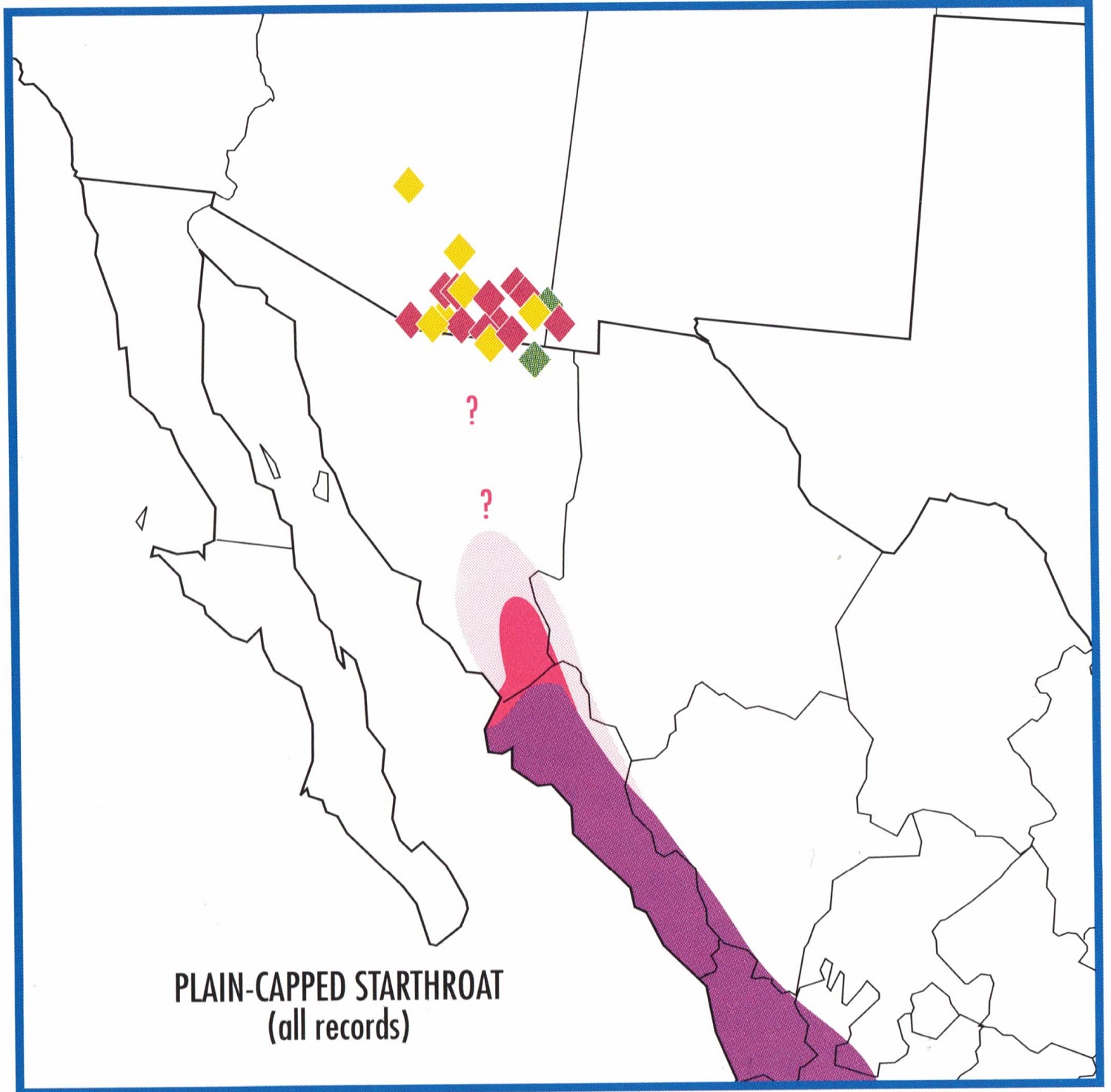
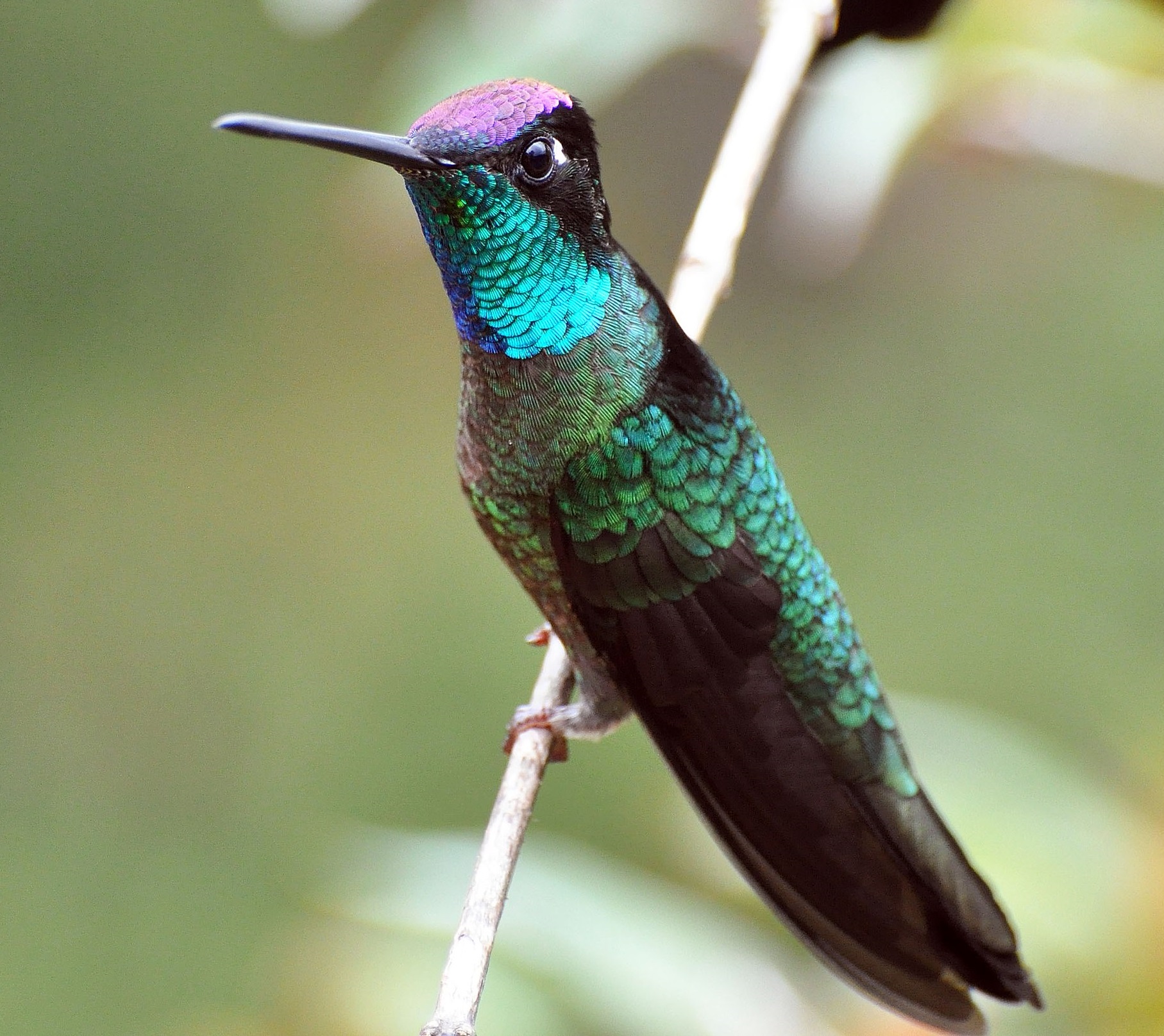
Rivoli’s Hummingbird
Eugenes fulgens
Order: Apodiformes
Family: Trochilidae
Size: 4.3 – 5.5in (11 – 14cm)
Overview
Like Anna’s hummingbird, Rivoli’s hummingbird is also named after a member of the Rivoli – specifically, the Duke of Rivoli, Anna’s husband. This species used to be called the Magnificent Hummingbird, but was recently renamed to distinguish itself from another species that has a blue gorget as opposed to the purple one that Rivoli’s hummingbird has. This particular avian is well-loved for its stunning colors in green and purple, and for its long body! It has one of the longest bills in the hummingbird species, and its heart rate can reach a blistering pace of 1,200 bpm!
How to Identify
Rivoli’s hummingbirds are wildly colored in waves of green, blue and purple, with touches of yellow. They are fairly large as hummingbird species go, and they are easy to spot as they have quite long, tall statures compared to others that are native in the US!
Rivoli’s Hummingbird Range & Migration Map
Rivoli’s hummingbirds breed primarily in the mountain ranges of western Texas, southeastern Arizona, and south-central New Mexico. The males are highly nomadic and banded birds have traveled hundreds of miles in a season. Sightings of this species can be seen in Colorado (May to October), Alabama (September to February), Arkansas (July), California (April), Georgia (winter), Minnesota (July), Nevada (June), Utah (July), Wyoming (June to July).
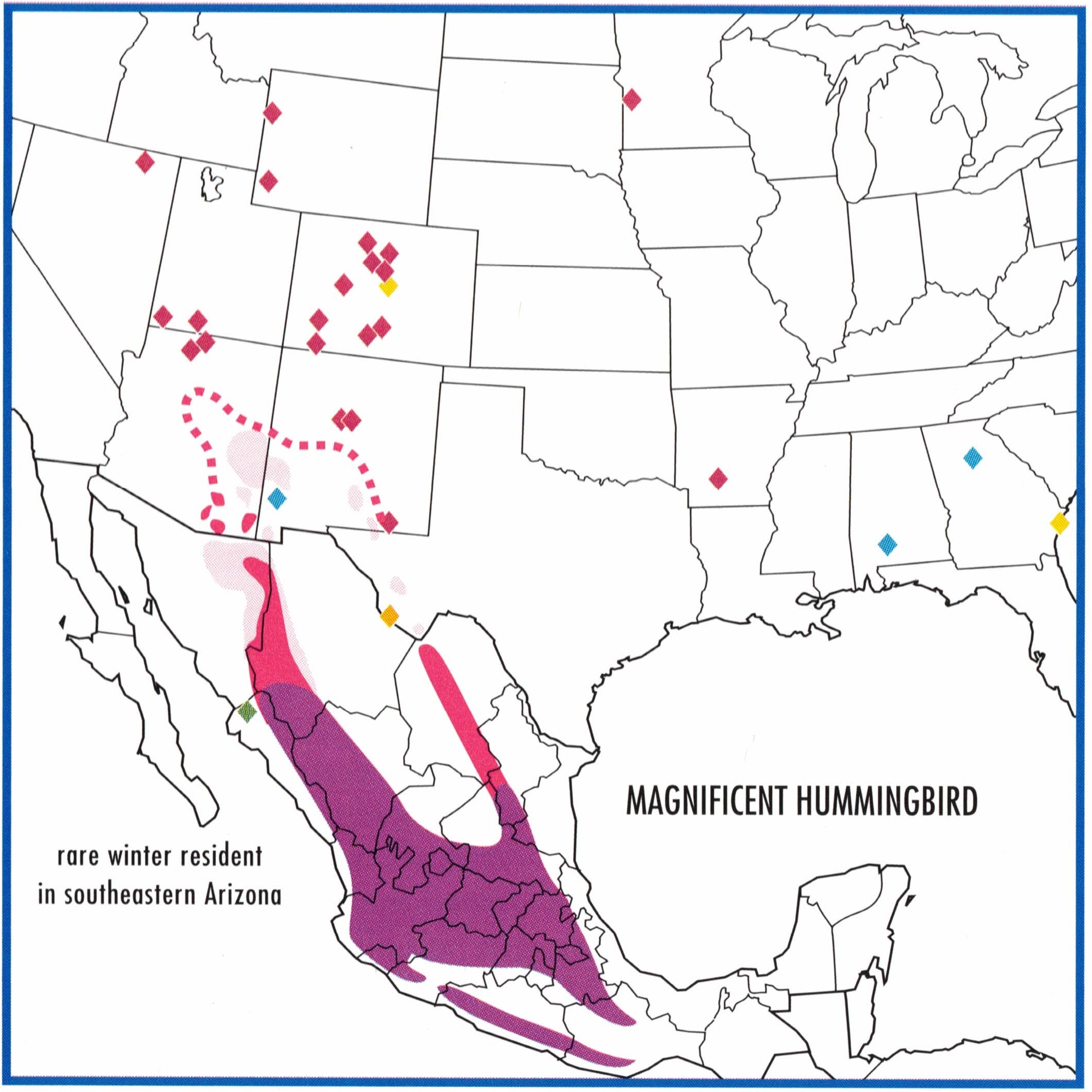
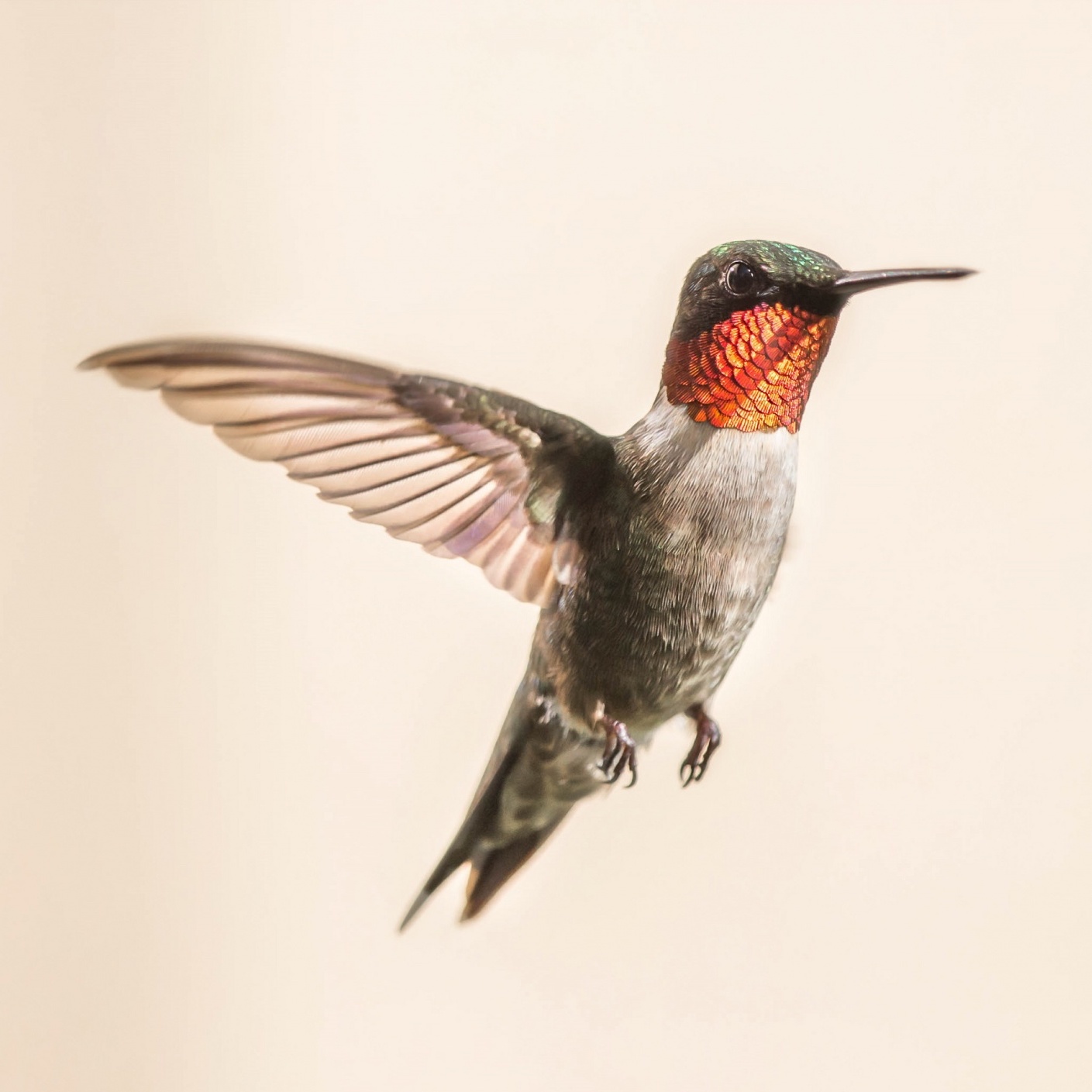
Ruby-Throated Hummingbird
Archilochus colubris
Order: Apodiformes
Family: Trochilidae
Size: 3.25 – 3.75 in (8.5 – 9.5cm)
Overview
The ruby-throated hummingbird is one of the most commonly found hummingbirds of the United States. In fact, it’s the only one that breeds east of the Mississippi River. To reach these eastern breeding grounds, the Ruby-Throated Hummingbird takes a perilous route of flying over 500 miles non-stop over the Gulf of Mexico.
How to Identify
This hummingbird is on the smaller side. The male sports a handsome scarlet gorget and a black chin strap which distinguishes it from the Anna’s and Broad-Tailed hummingbirds.
Ruby-Throated Hummingbird Range & Migration Map
The Ruby-Throated hummingbird breeds in eastern United States and prefers hardwood, pine and mixed forests starting in the spring and retreats to Mexico in the winter.
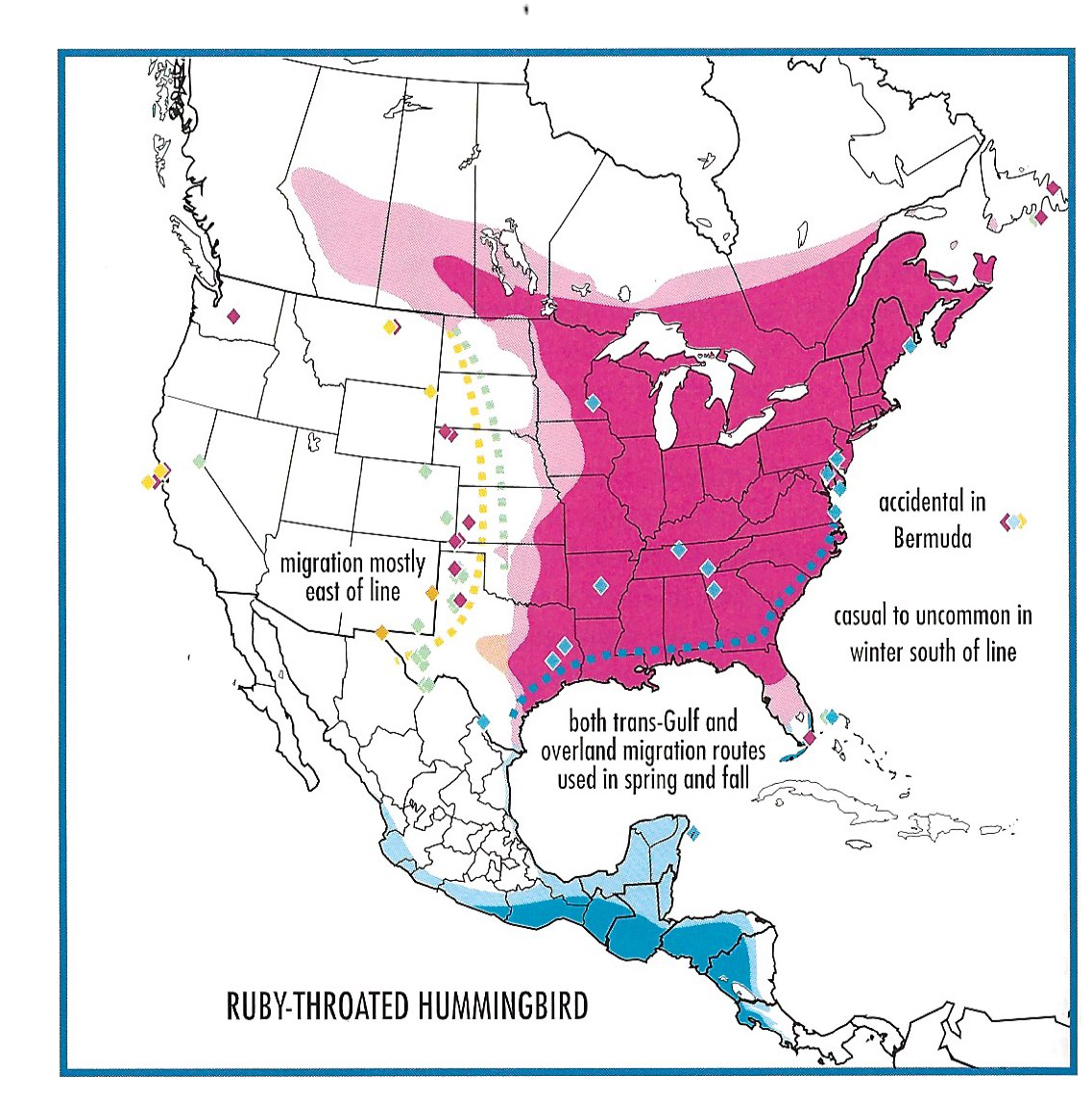
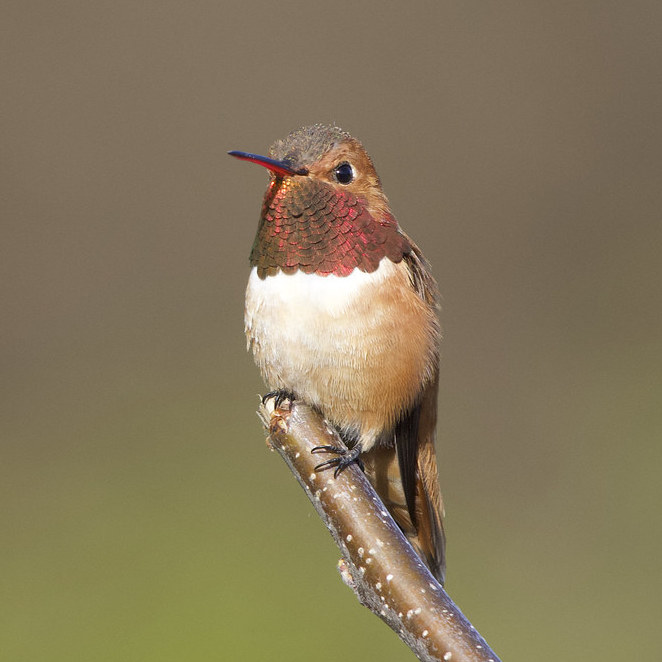
Rufous Hummingbird
Selasphorus rufus
Order: Apodiformes
Family: Trochilidae
Size: 3.5 – 4in (9 – 10cm)
Overview
The Rufous Hummingbird breeds farther north than any other hummingbird in the United States. It’s an aggressive species which makes it an unwelcome guest among hummingbird feeders. This hummingbird is an important part of the Pacific Northwest ecosystem, acting as a pollinator where the insects are at a disadvantage due to their cold-bloodedness.
How to Identify
The most distinguishing feature of the Rufous Hummingbird is the male’s rufous gorget that’s hard to miss. It’s a relatively small hummingbird with a short black bill. With the rufous plumage and aggressive behaviour, you’ll have no problem identifying male Rufous Hummingbirds.
Rufous Hummingbird Range & Migration Map
The Rufous Hummingbird breeds from the southeastern tip of Alaska down to the northern most parts of California, going as far east as Montana. During the winter, it migrates down to the Gulf of Mexico states.
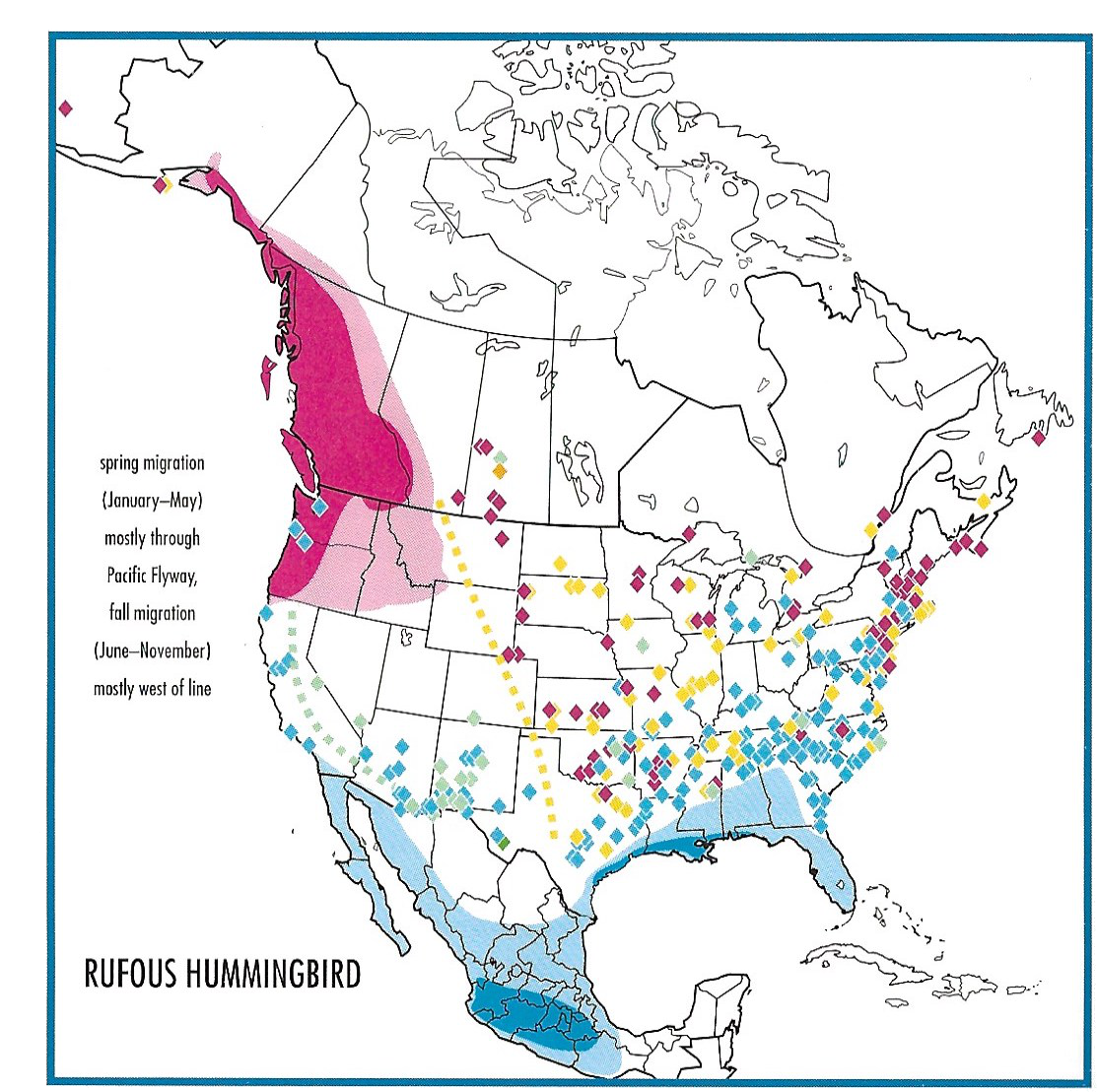
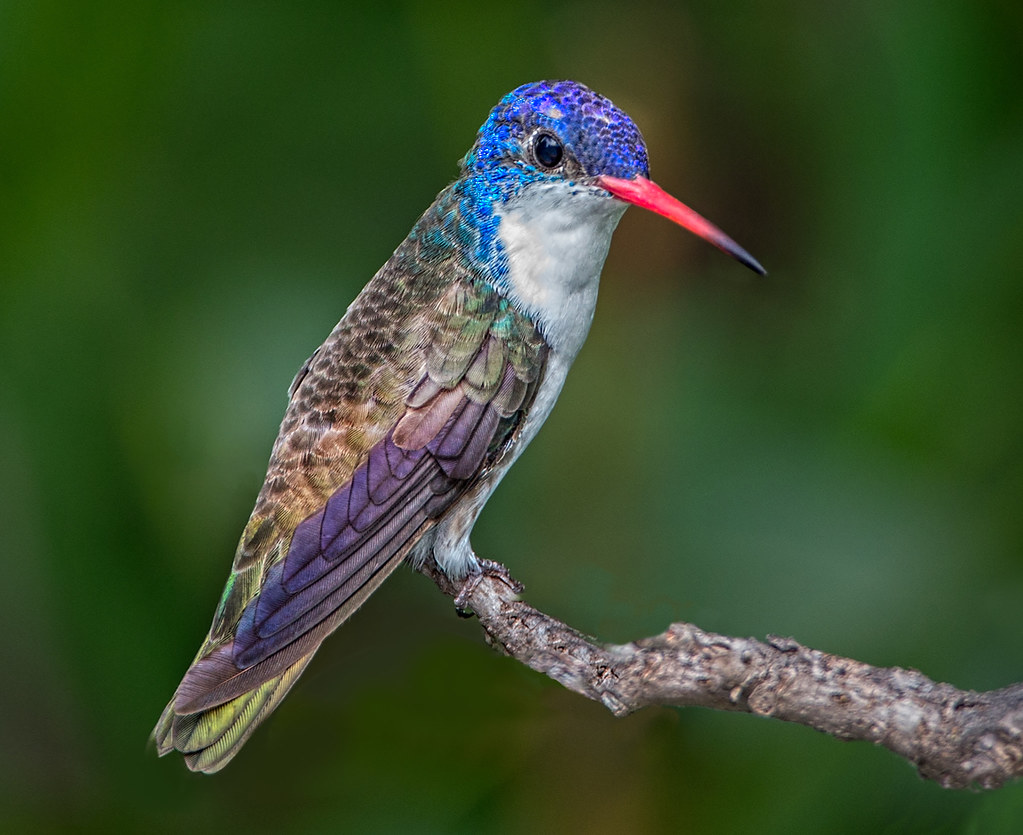
Violet-Crowned Hummingbird
Amazilia violiceps
Order: Apodiformes
Family: Trochilidae
Size: 4 – 4.5in (10 – 11.5cm)
Overview
The Violet-Crowned Hummingbird while very localized in the United States, is one of the most distinctive hummingbird species. The coral red bill and perfect white underbelly makes this hummingbird easy to spot and identify. This aggressive hummingbird’s habitat consists mostly of sycamores near streams but may seek out feeders during the winter. It frequently chases other hummingbirds.
How to Identify
As we mentioned above, the Violet-Crowned Hummingbird is easy to identify. It’s a medium-large sized hummingbird with a red coral bill that sports a black tip. It also has an immaculate white underpart and a violet colored crown. Both male and female show the same color markings while the female hummingbird may show less dramatic coloring on its plumages.
Violet-Crowned Hummingbird Range & Migration Map
The Violet-Crowned Hummingbird breeds in southeastern Arizona and usually retreats south to Mexico in the winter.
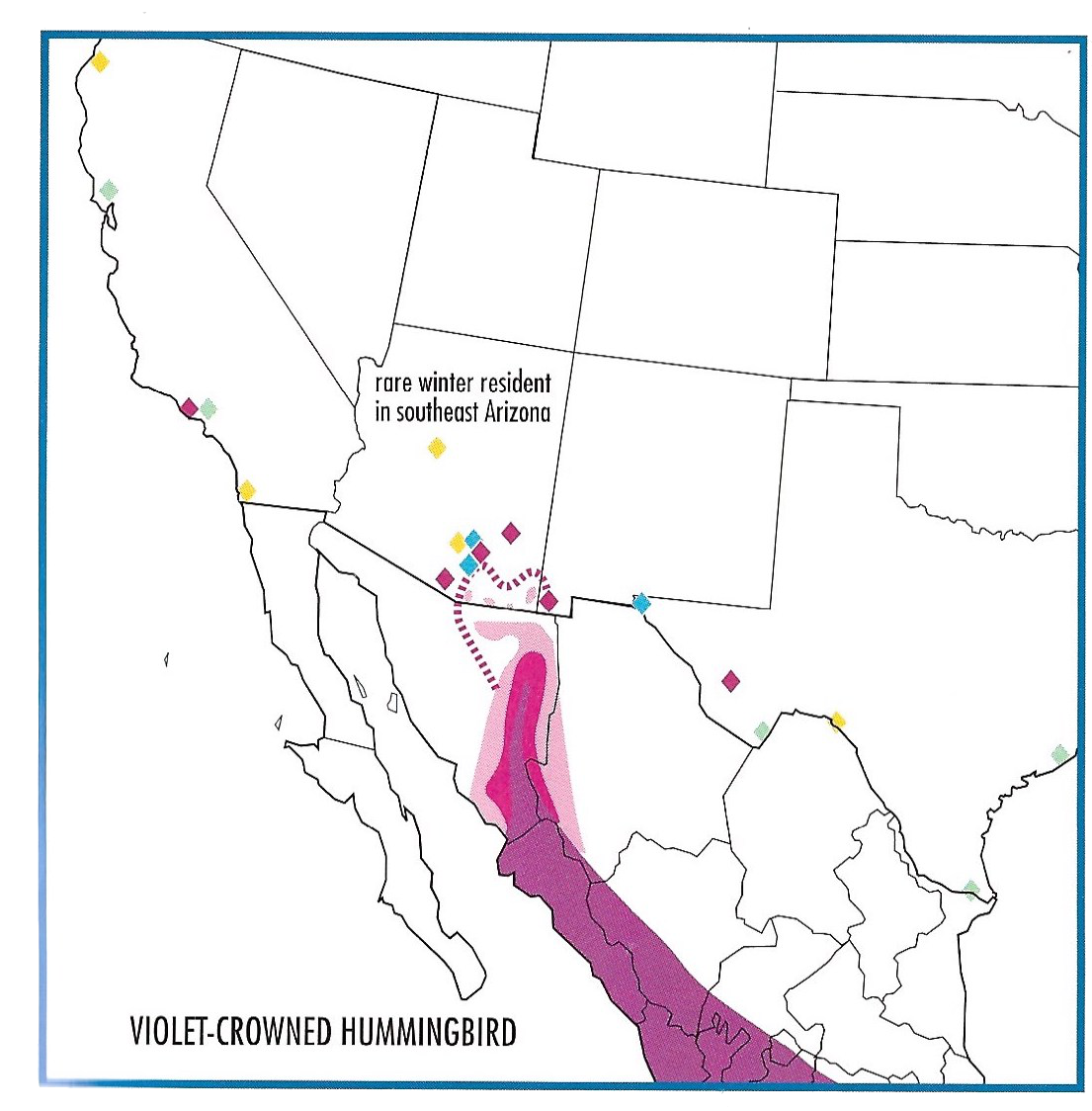
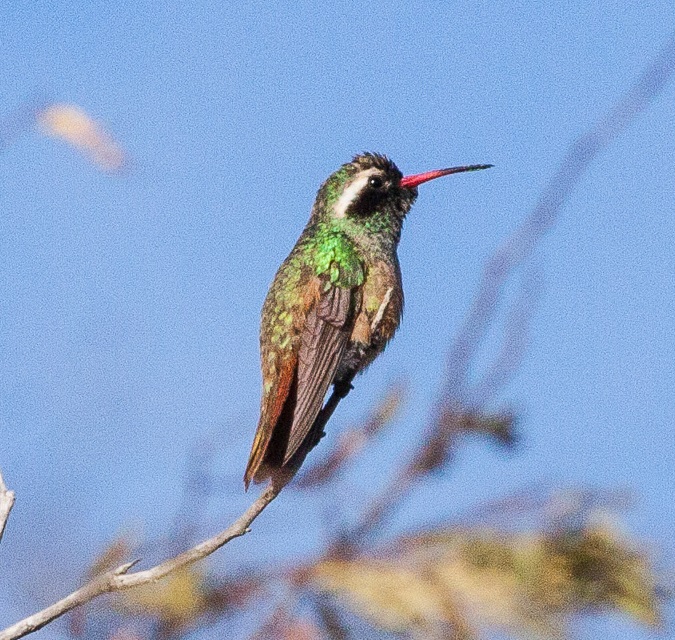
Xantus’s Hummingbird
Basilinna xantusii
Order: Apodiformes
Family: Trochilidae
Size: 3 – 3.5in (8 – 9cm)
Overview
Xantus’s hummingbird is a curious species that can be confused for white-eared hummingbirds on sight alone, however, you’re more likely to see these vagrant birds in Baja California. An extremely rare sight, this striking bird tends to prefer pine and oak woods and even desert areas – they’re not thought to be threatened, but their movement is very curious (more below).
How to Identify
Boasting a white stripe (hence the white-eared confusion) across its face, with lark red beaks and vibrant green plumes, these hummingbirds are delightful to watch if you are lucky enough to spot them. Males tend to have darker coloring, while females can have buff colors in the face.
Xantus’s Hummingbird Range & Migration Map
Bizarrely, the Xanthus’s hummingbird is rarely seen outside of its native Baja. Only one Xanthus’s hummingbird made it to British Columbia – a female, in 1998. No birds of this species have been seen there since, and no one’s too sure why it traveled so far! A further bird of the species also made its way to Ventura, CA – where it failed to breed. It’s extraordinarily rare to see this bird act vagrant outside of its home zone.
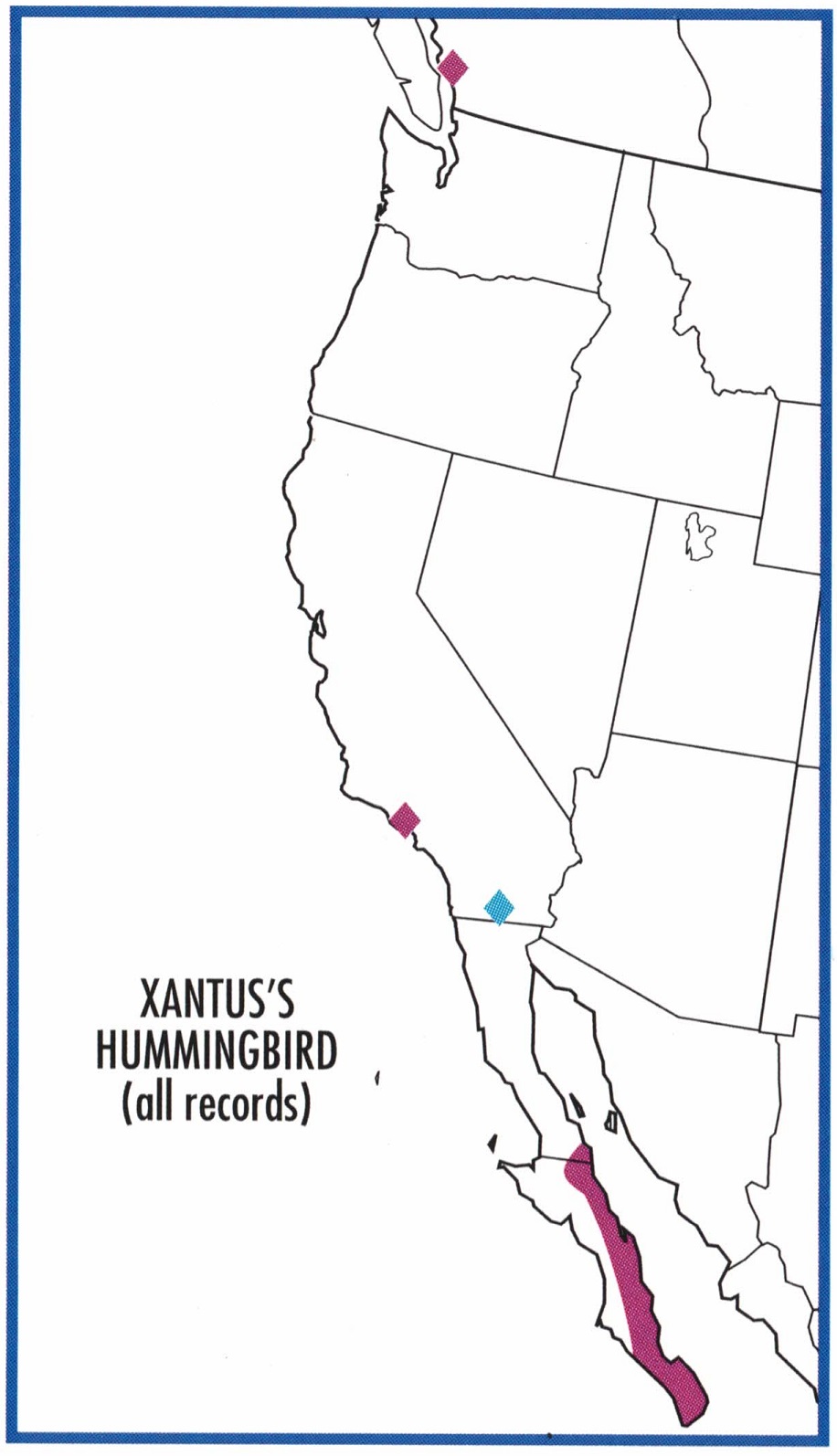
How to Attract United State Hummingbirds to Your Yard
Want to see more hummingbirds in your backyard?
We have all the information you need on our site to help you do that. First, we recommend you read our guide on how to attract hummingbirds to your yard. That’ll give you the basics of what’s required to attract hummingbirds.
Then, we’d recommend reading our buyer’s guide on choosing the best hummingbird feeder. Setting up a hummingbird feeder or two is the best way to guarantee that hummingbirds will visit your yard.
There are a bunch of other ways to attract hummingbirds such as getting a bird bath and planting native flowers that attract hummingbirds.
All State Hummingbirds
Want to see what hummingbirds species are found in other states? Here’s our complete list of hummingbirds found in each state:

What kind of hummingbird has a green stripe down it’s back?